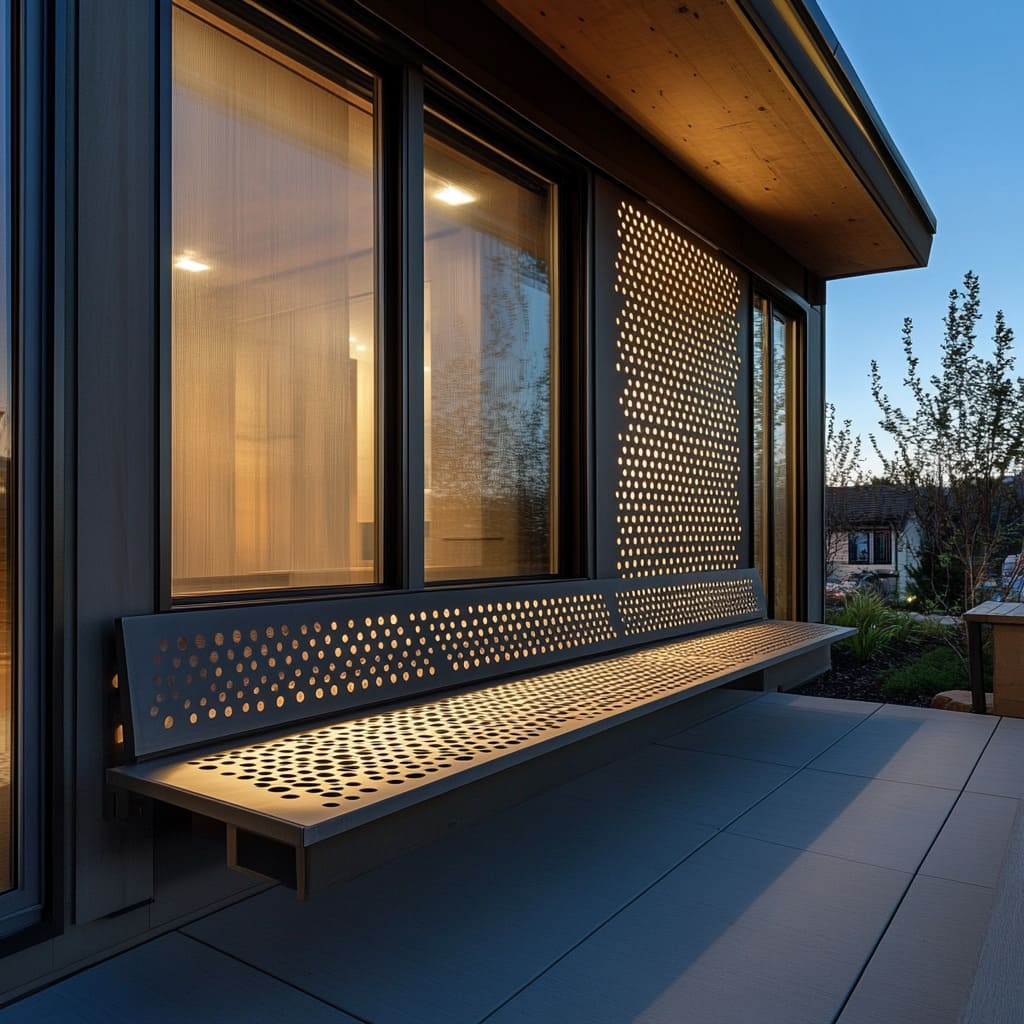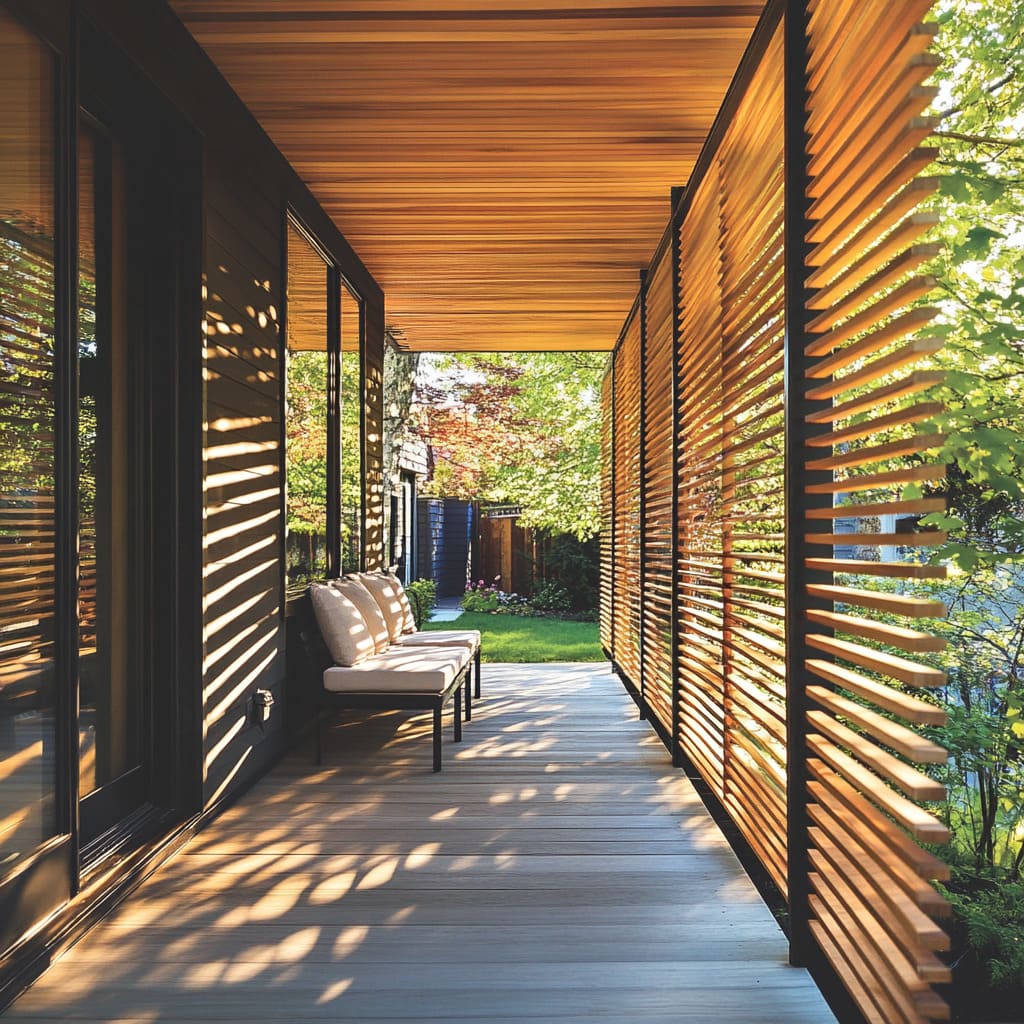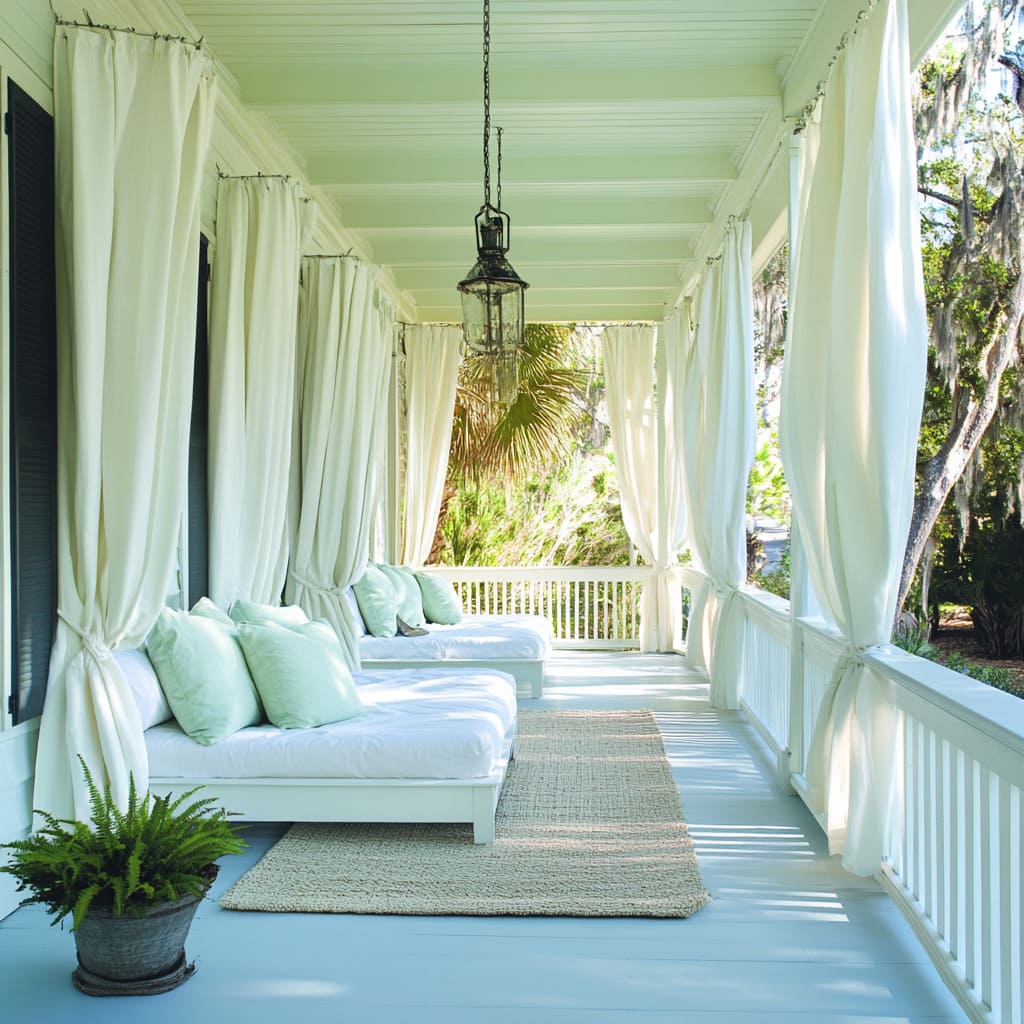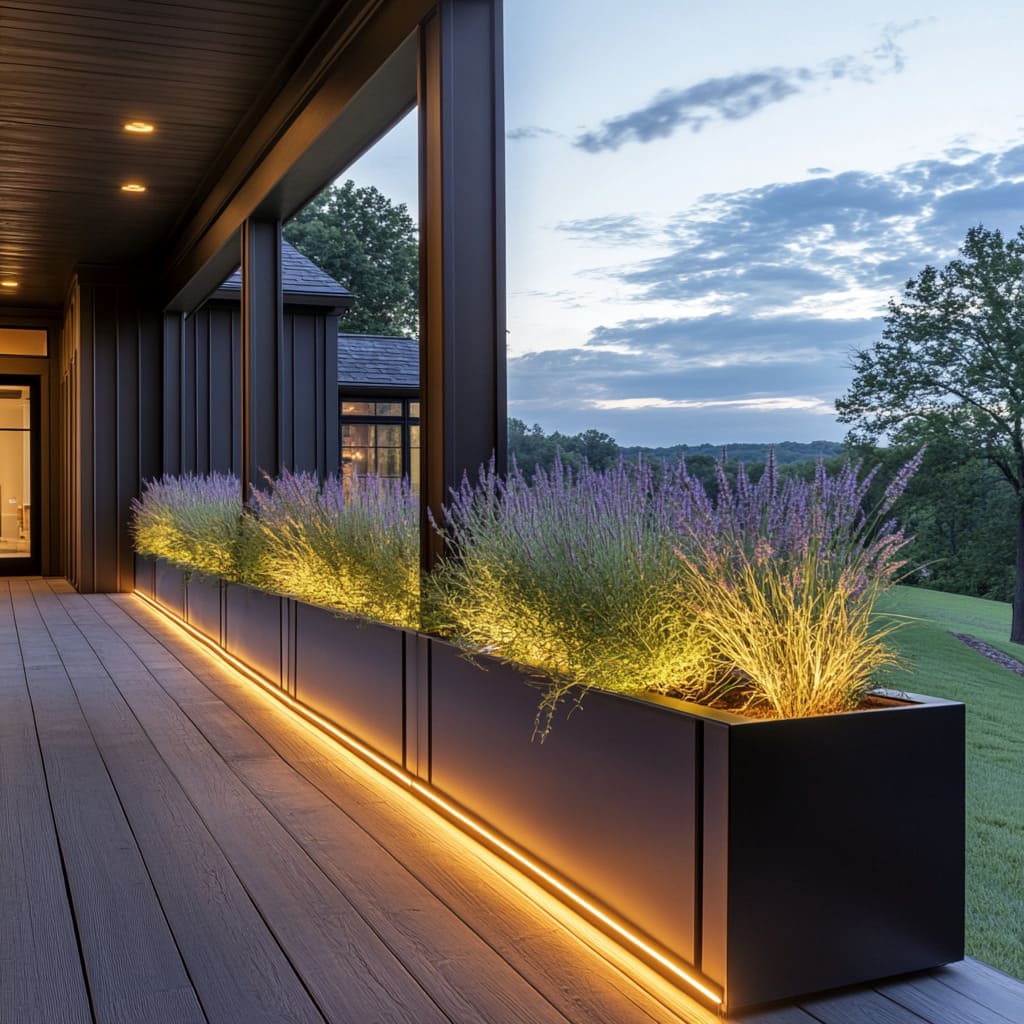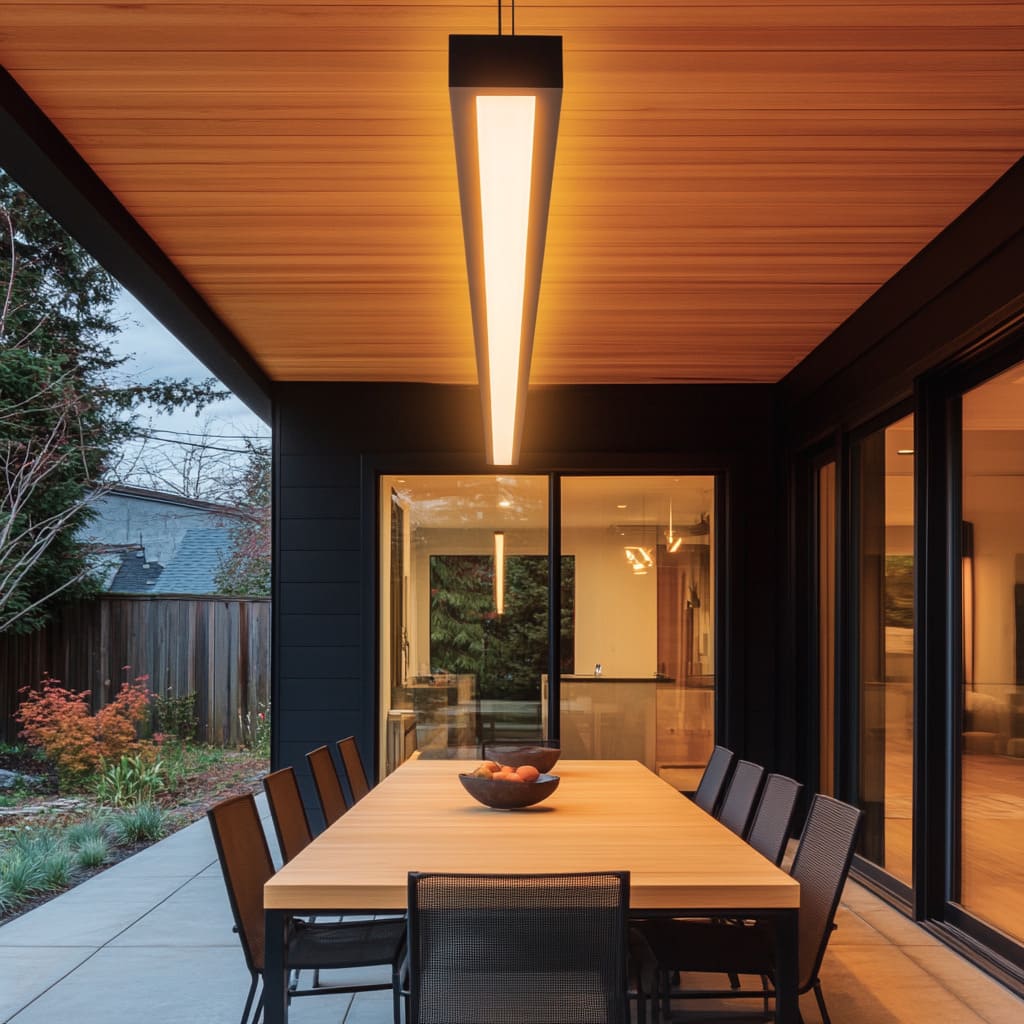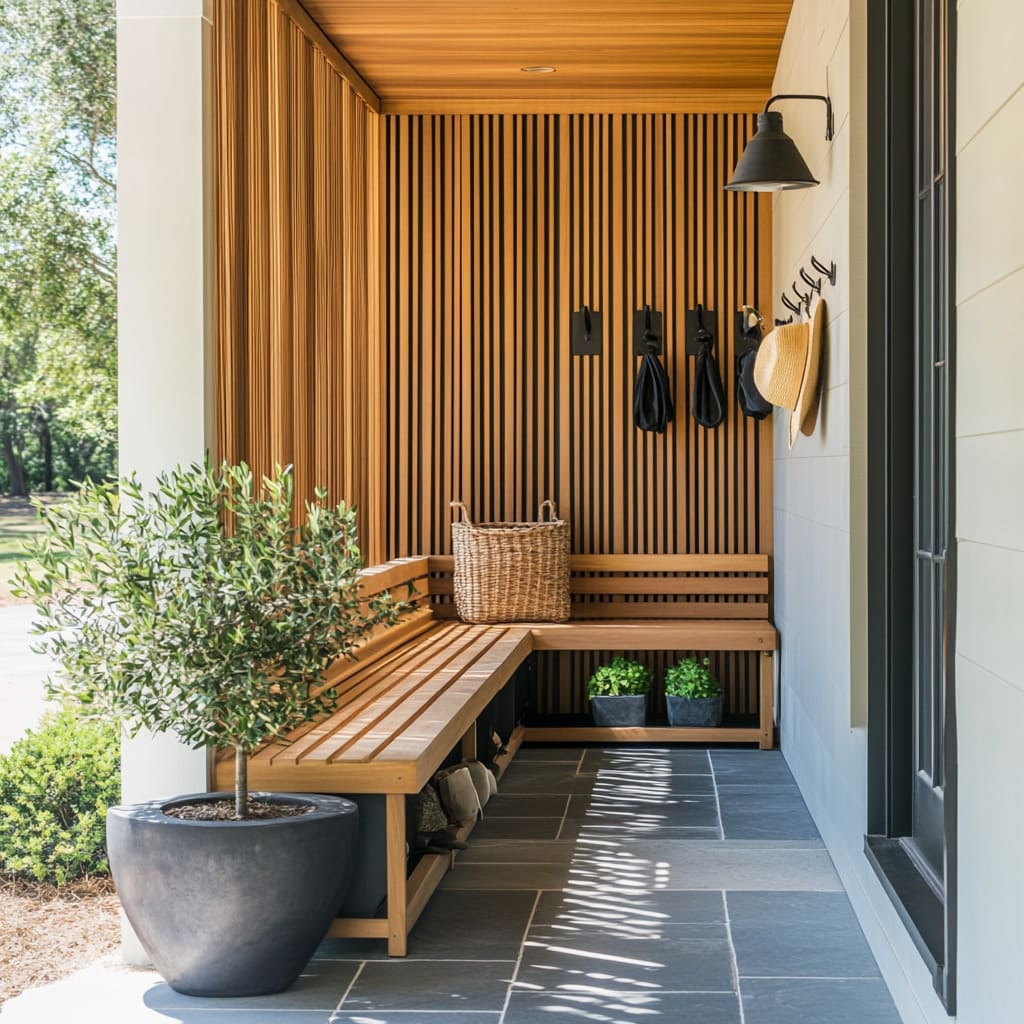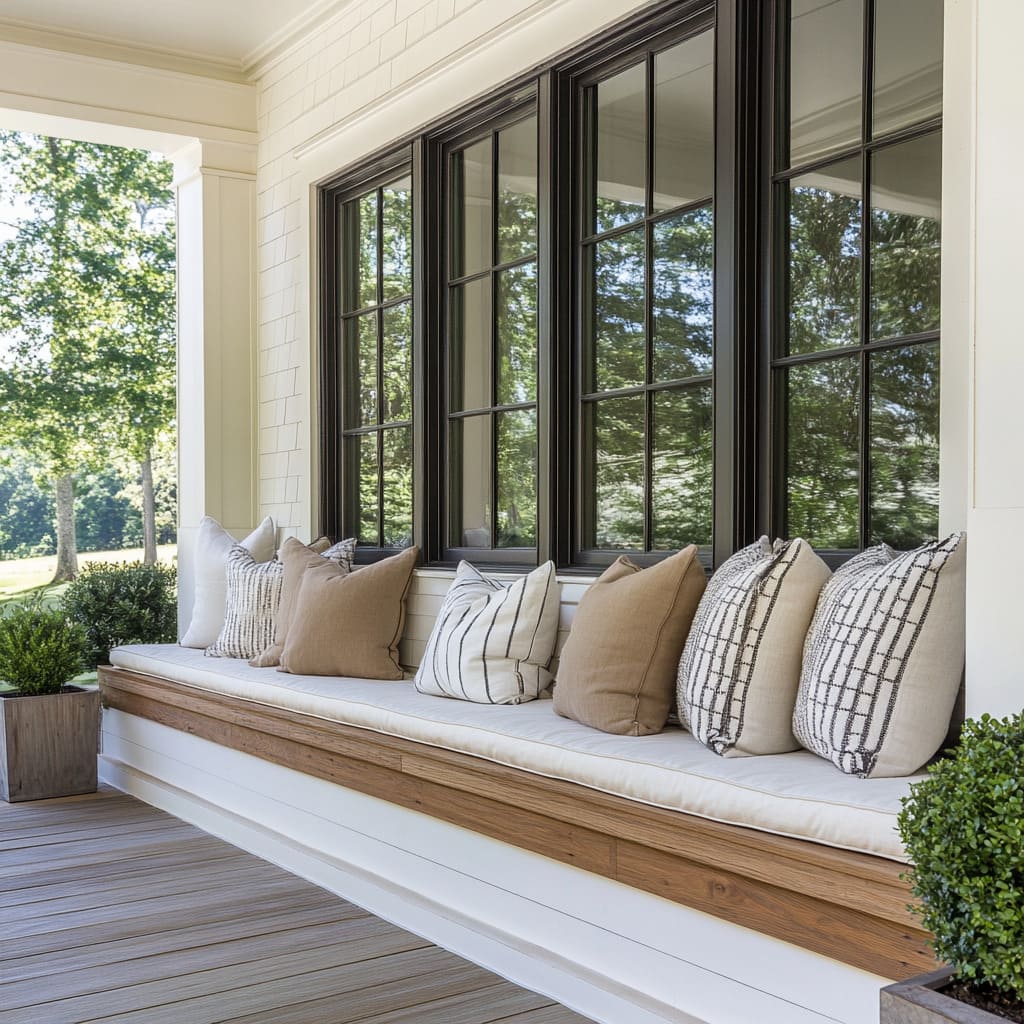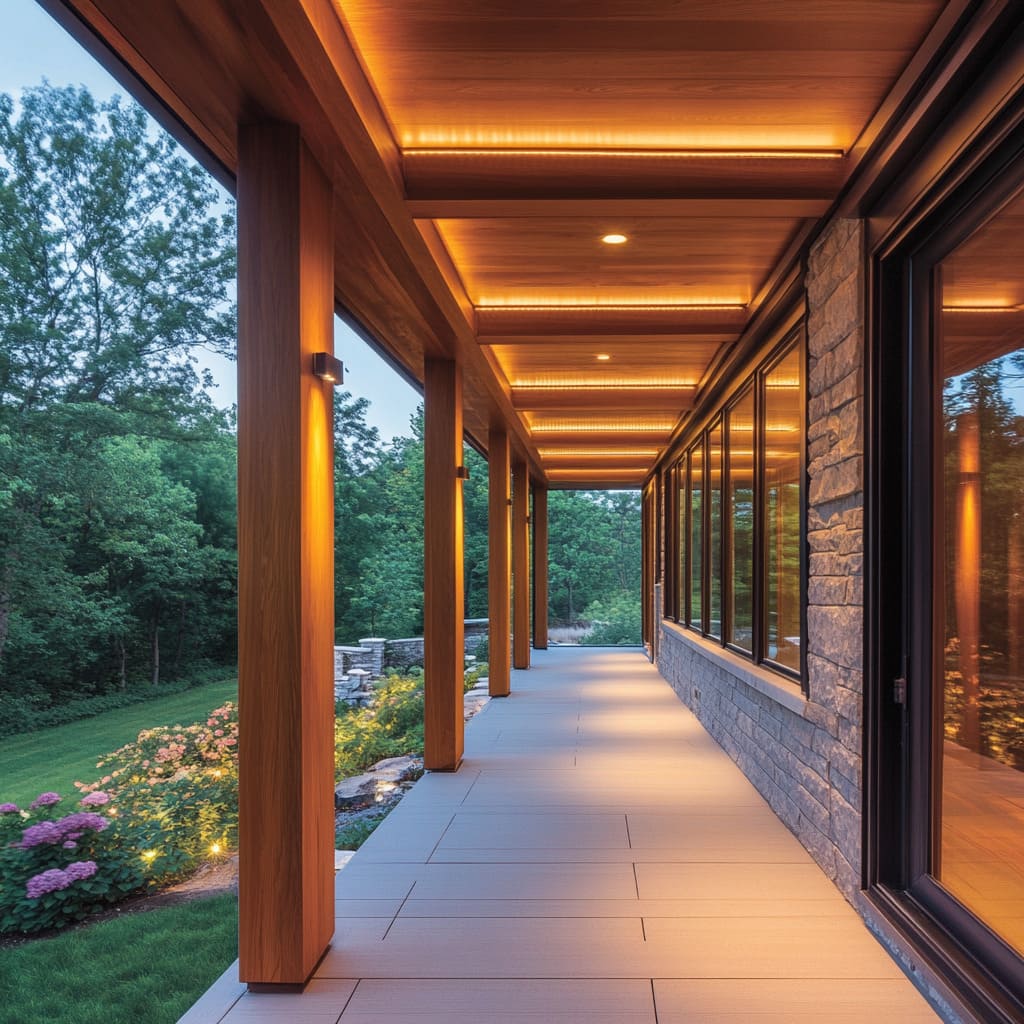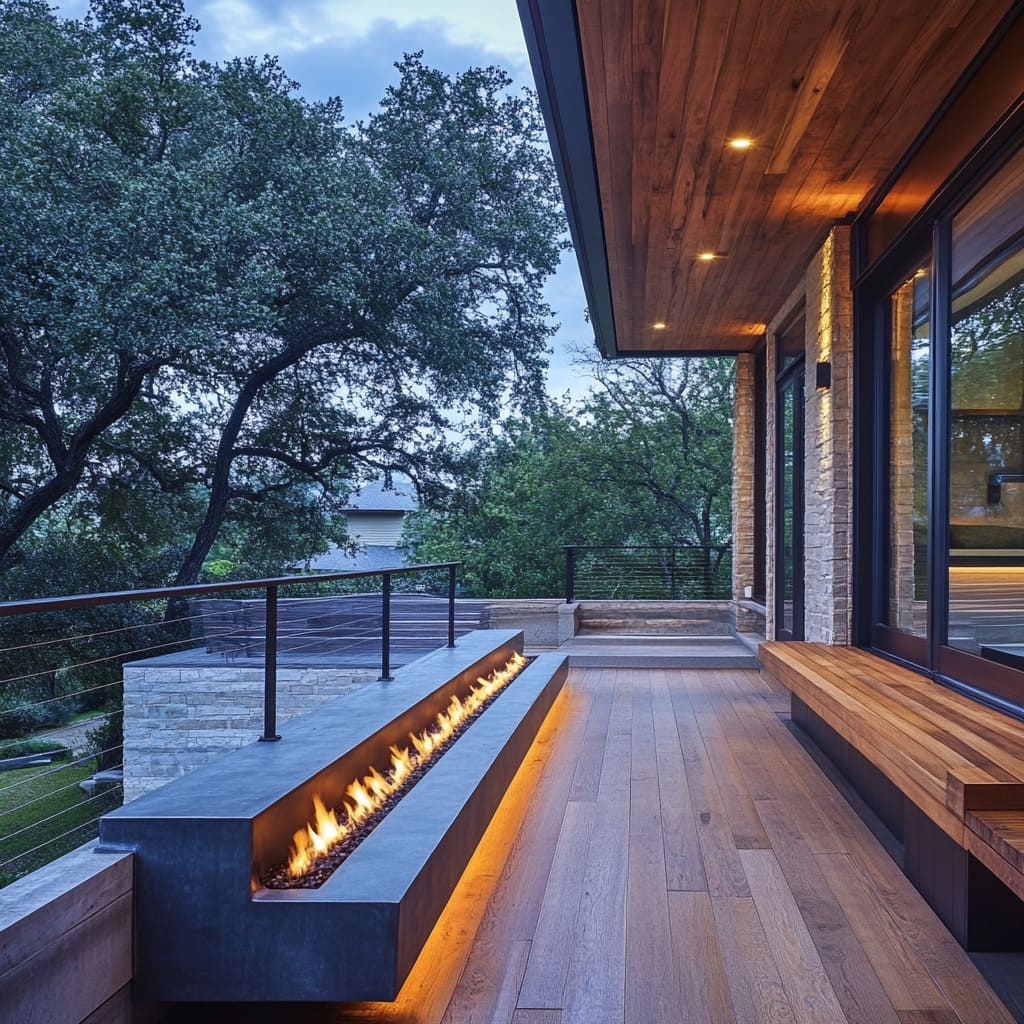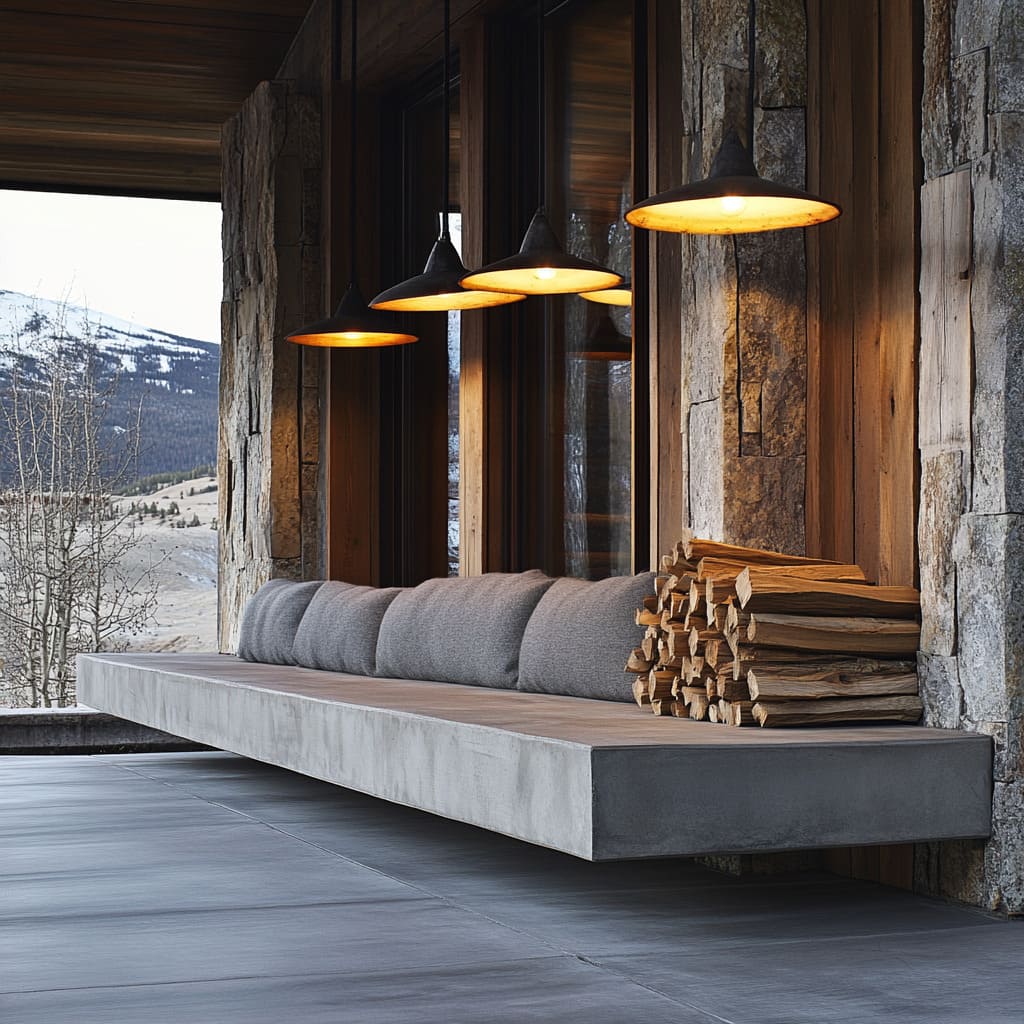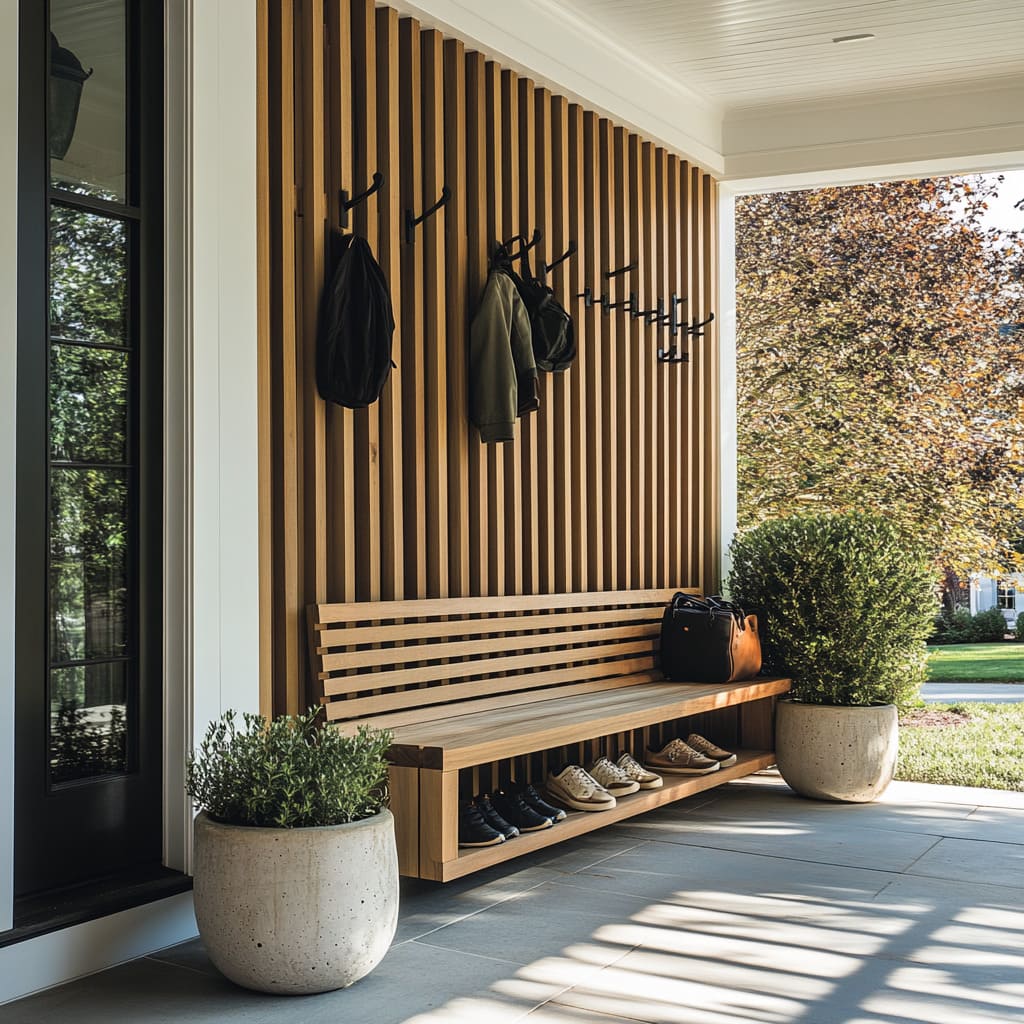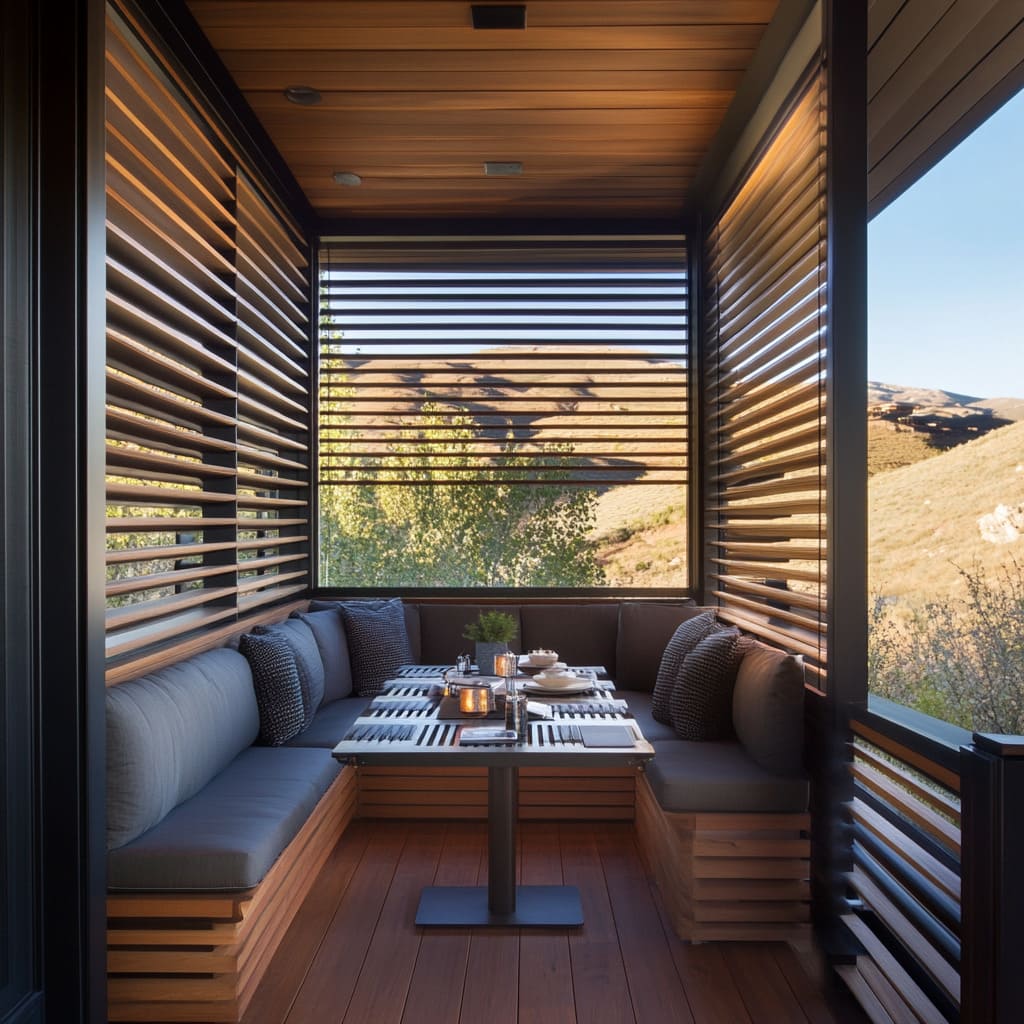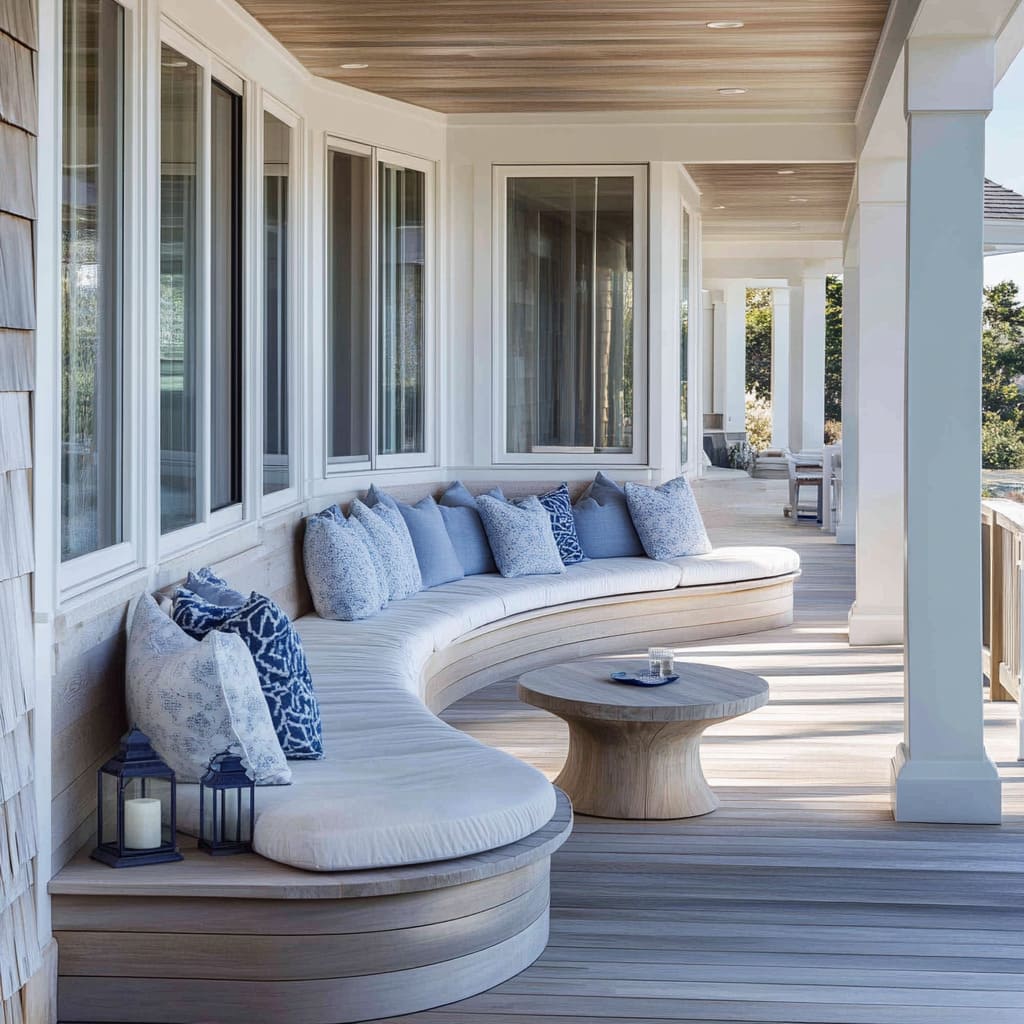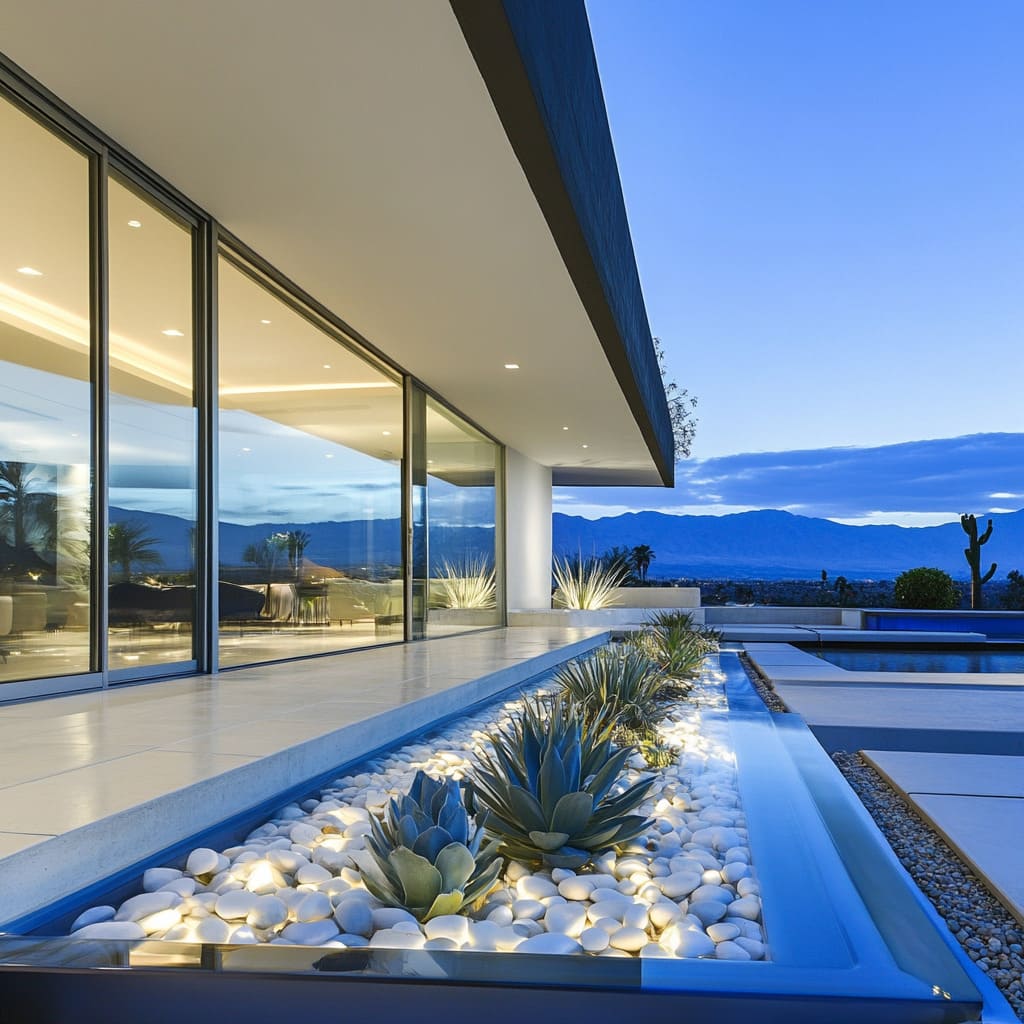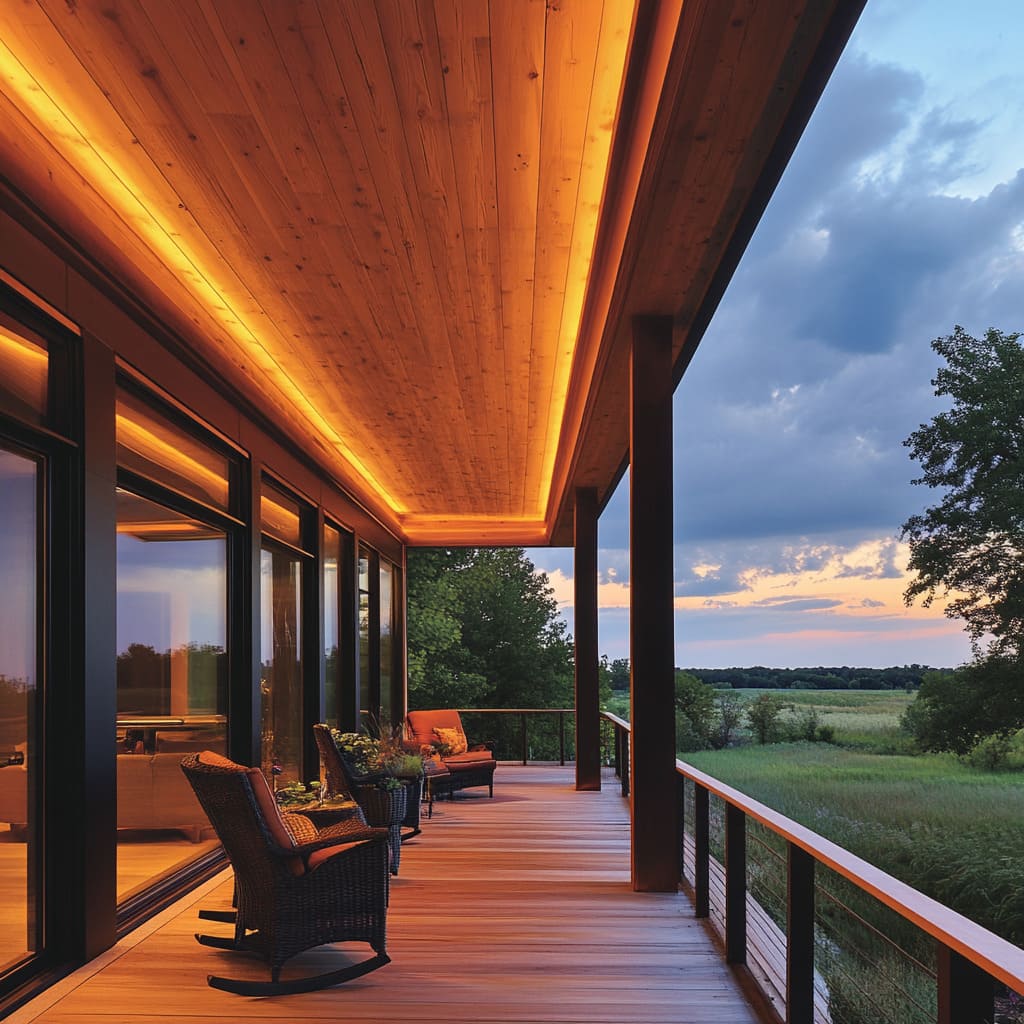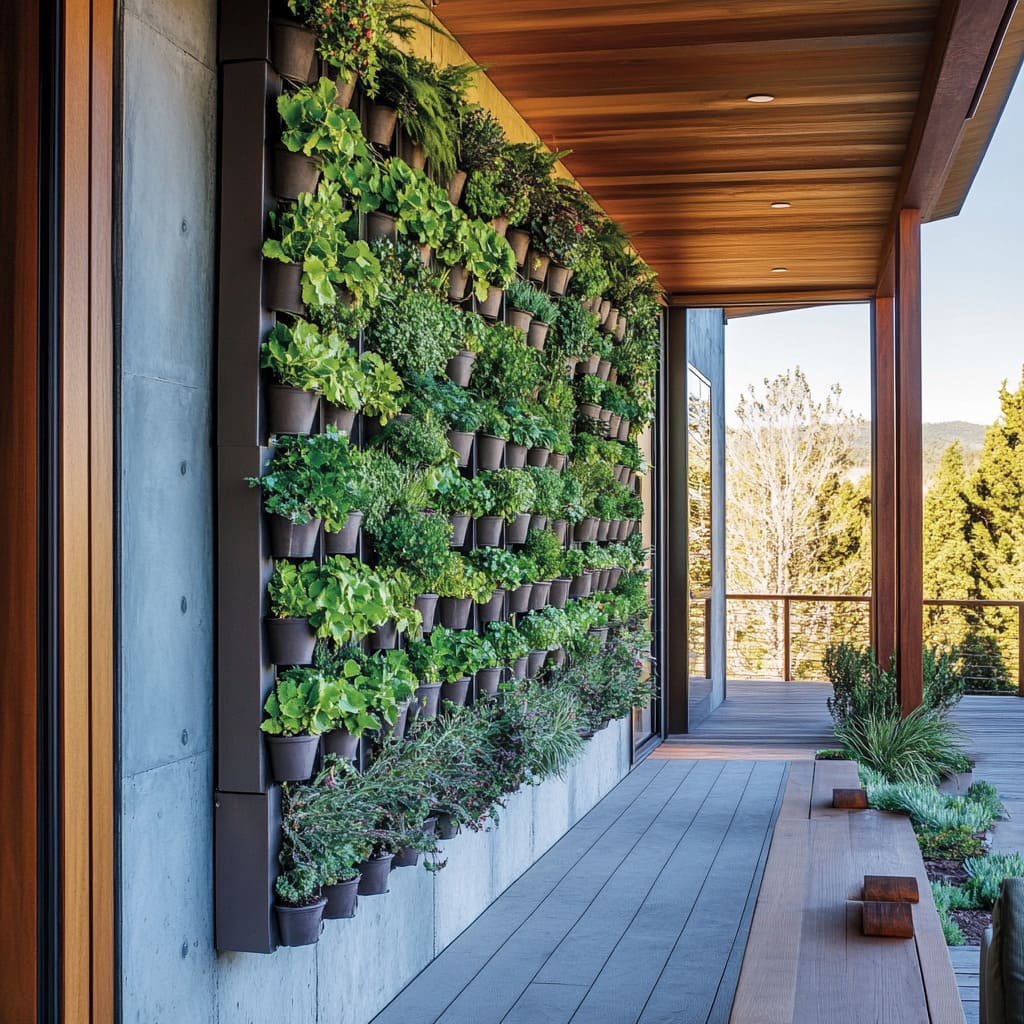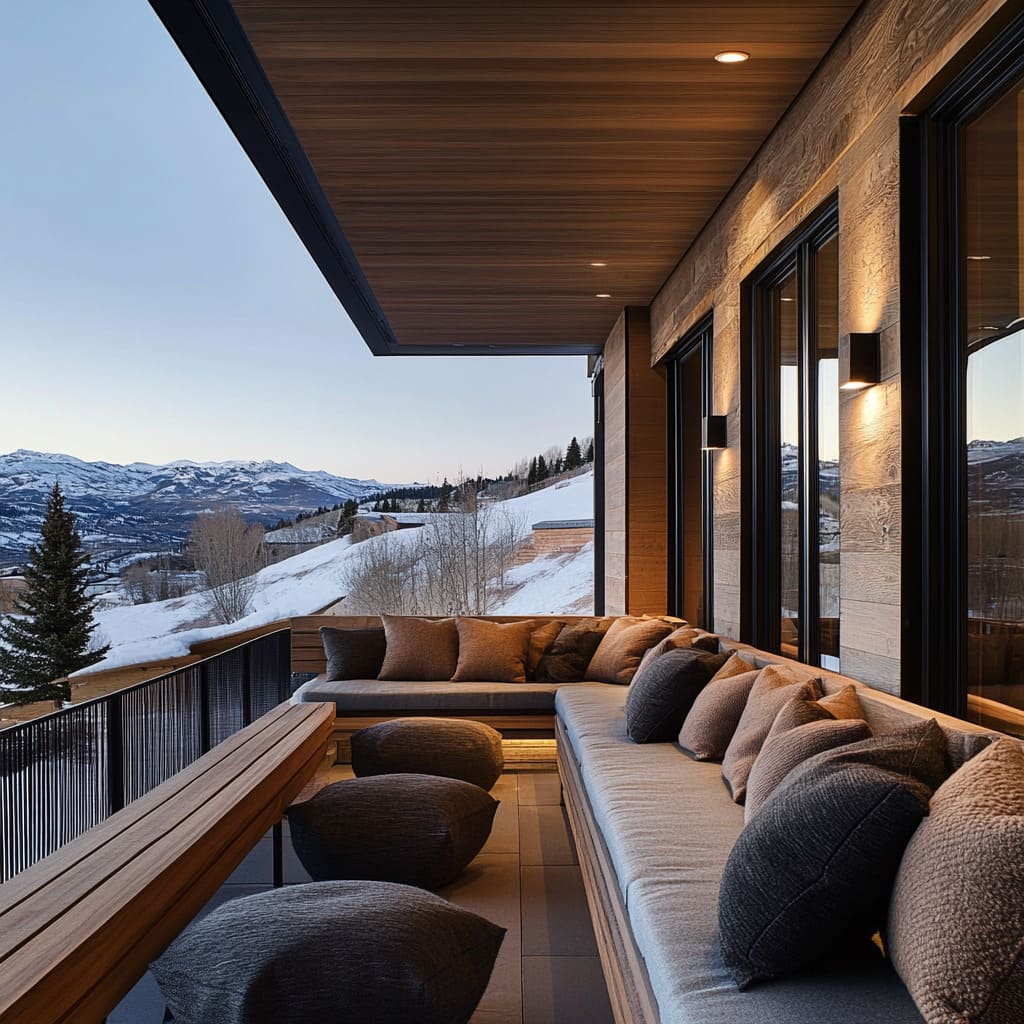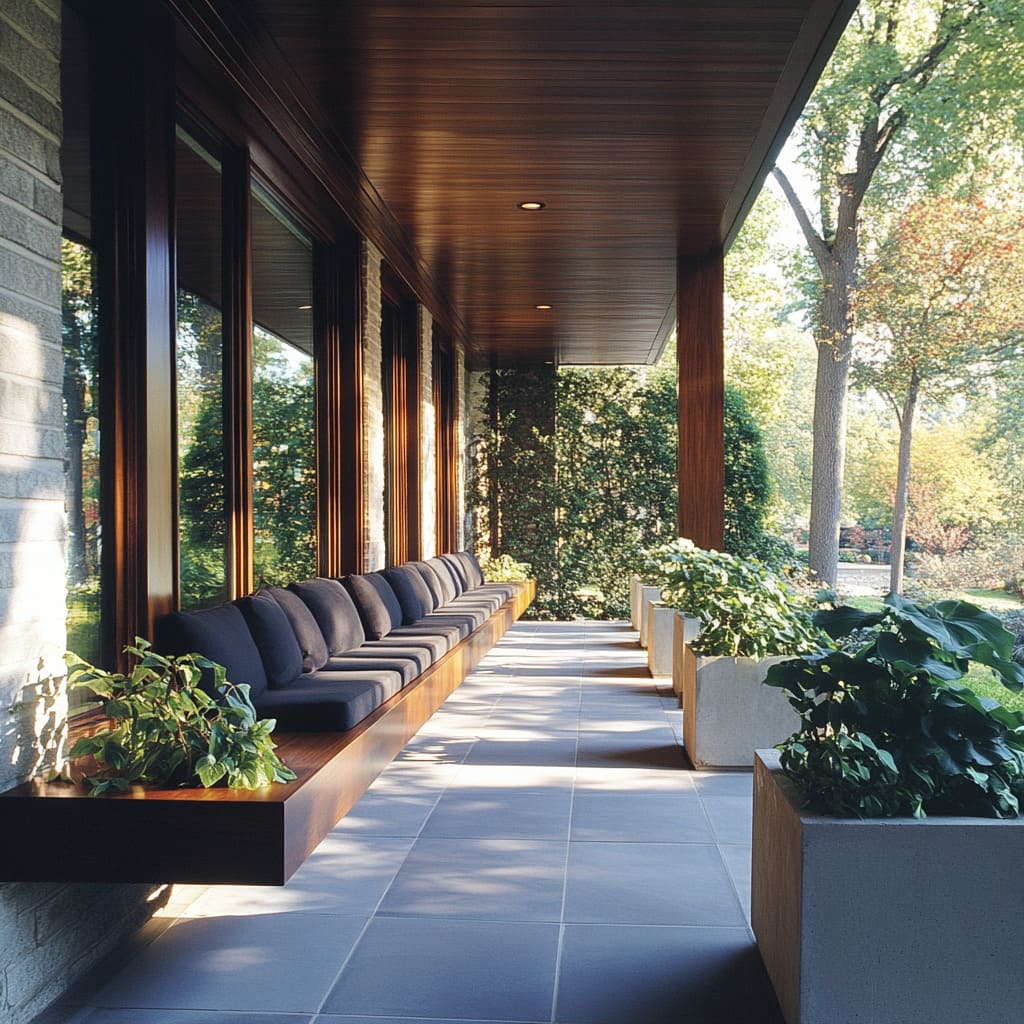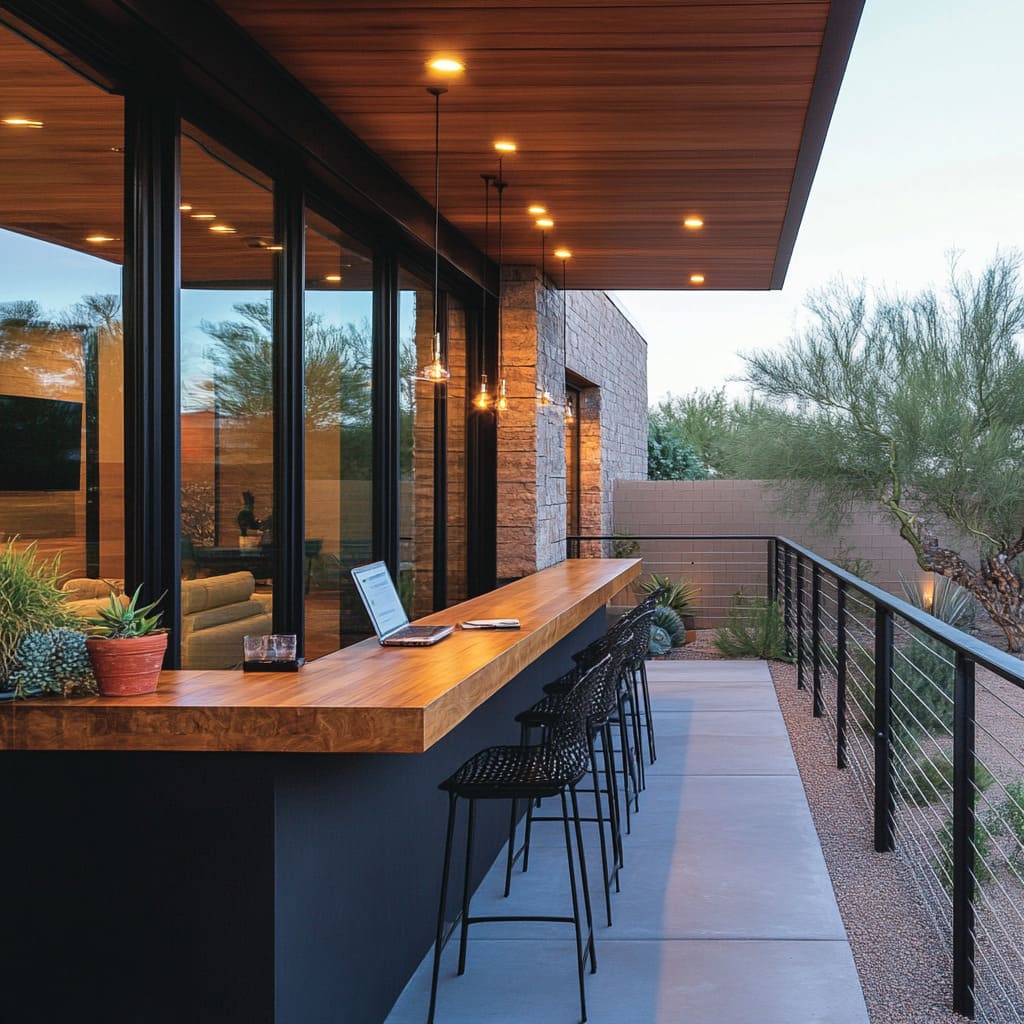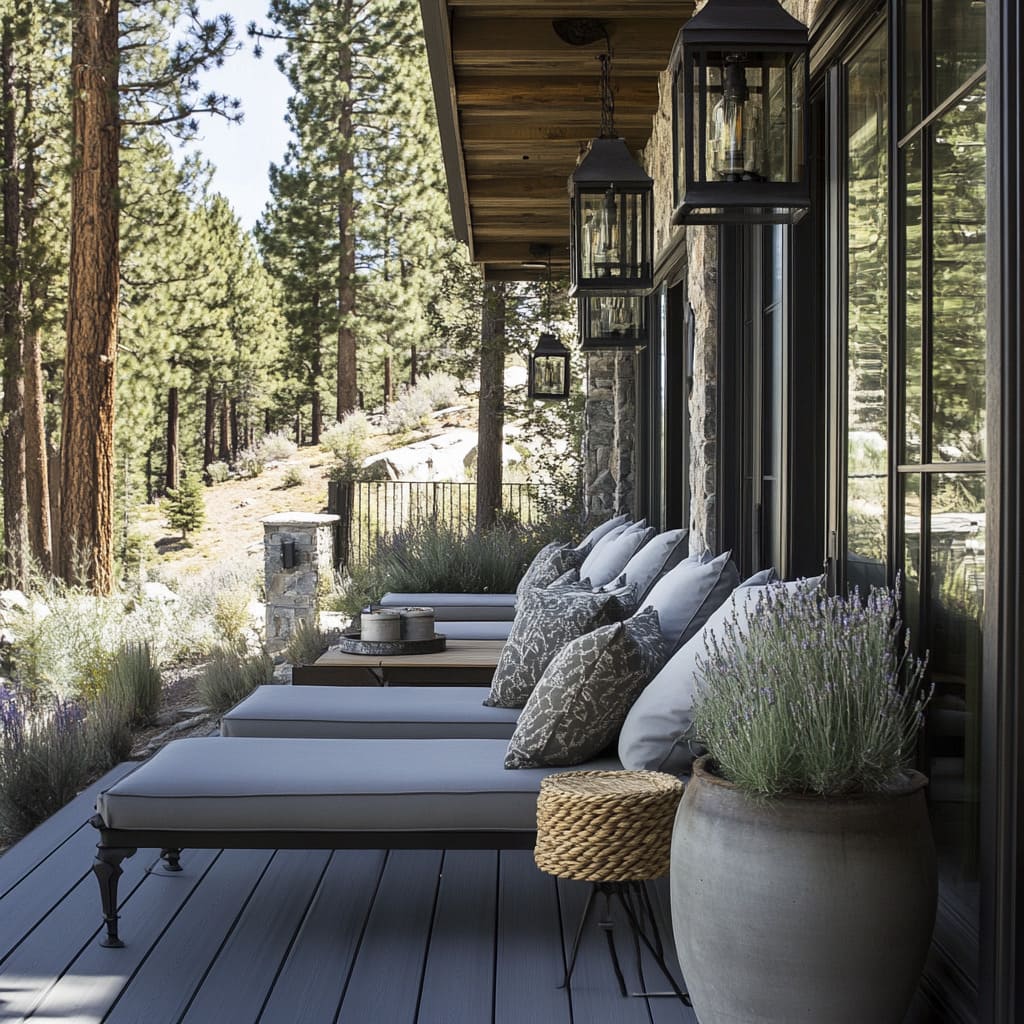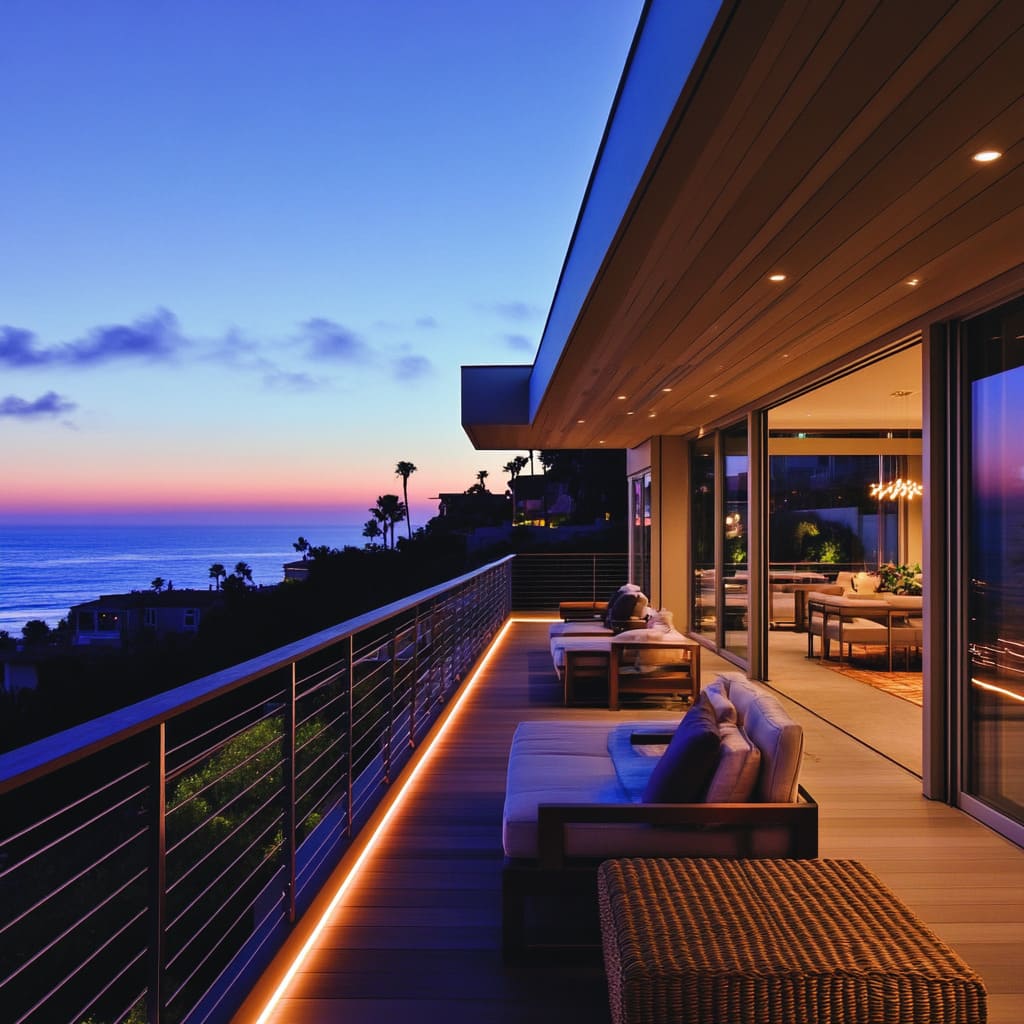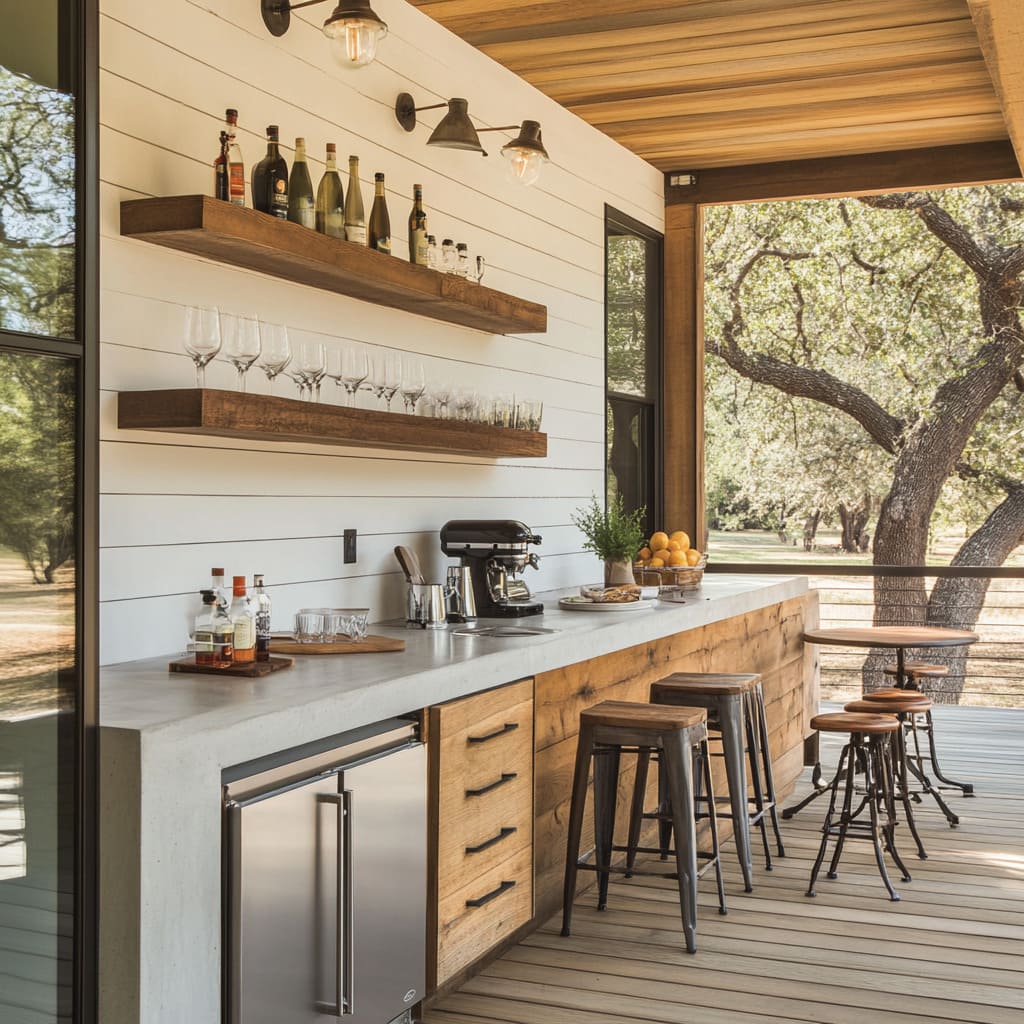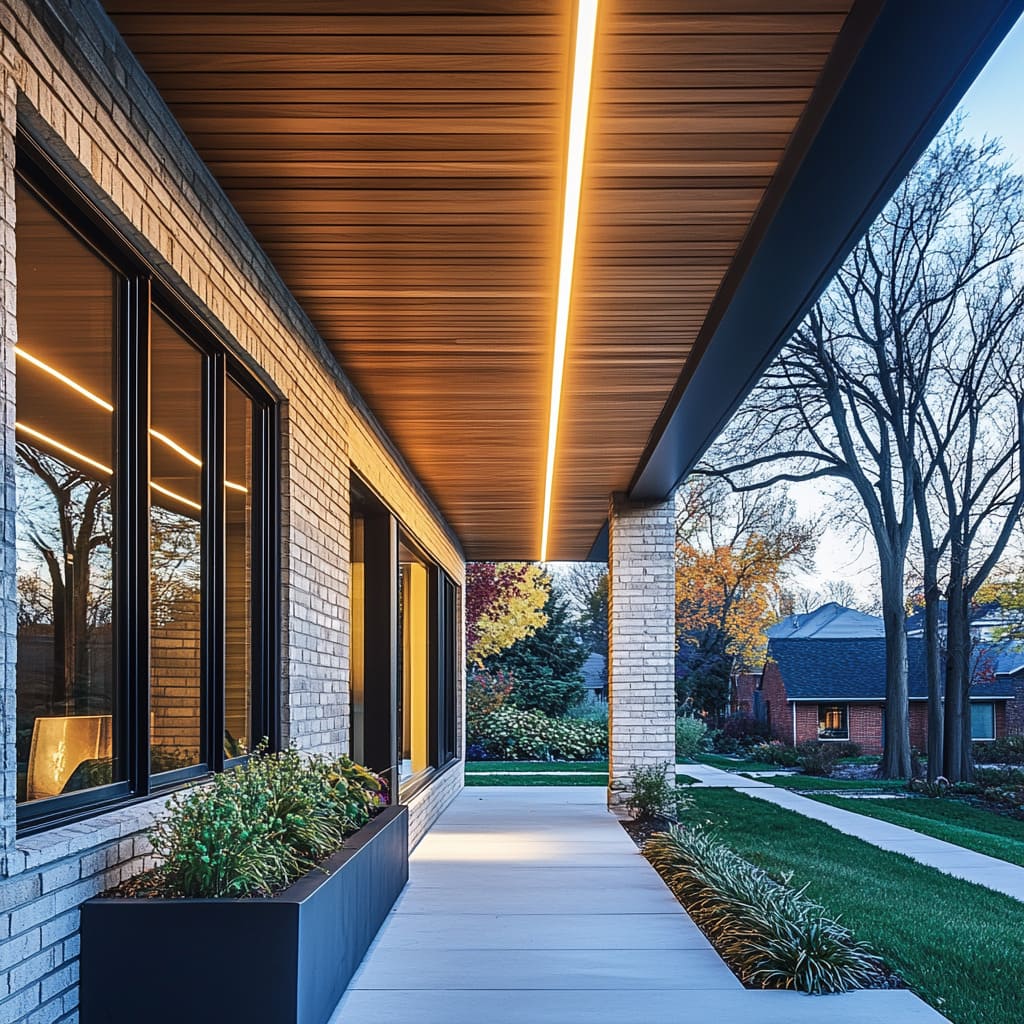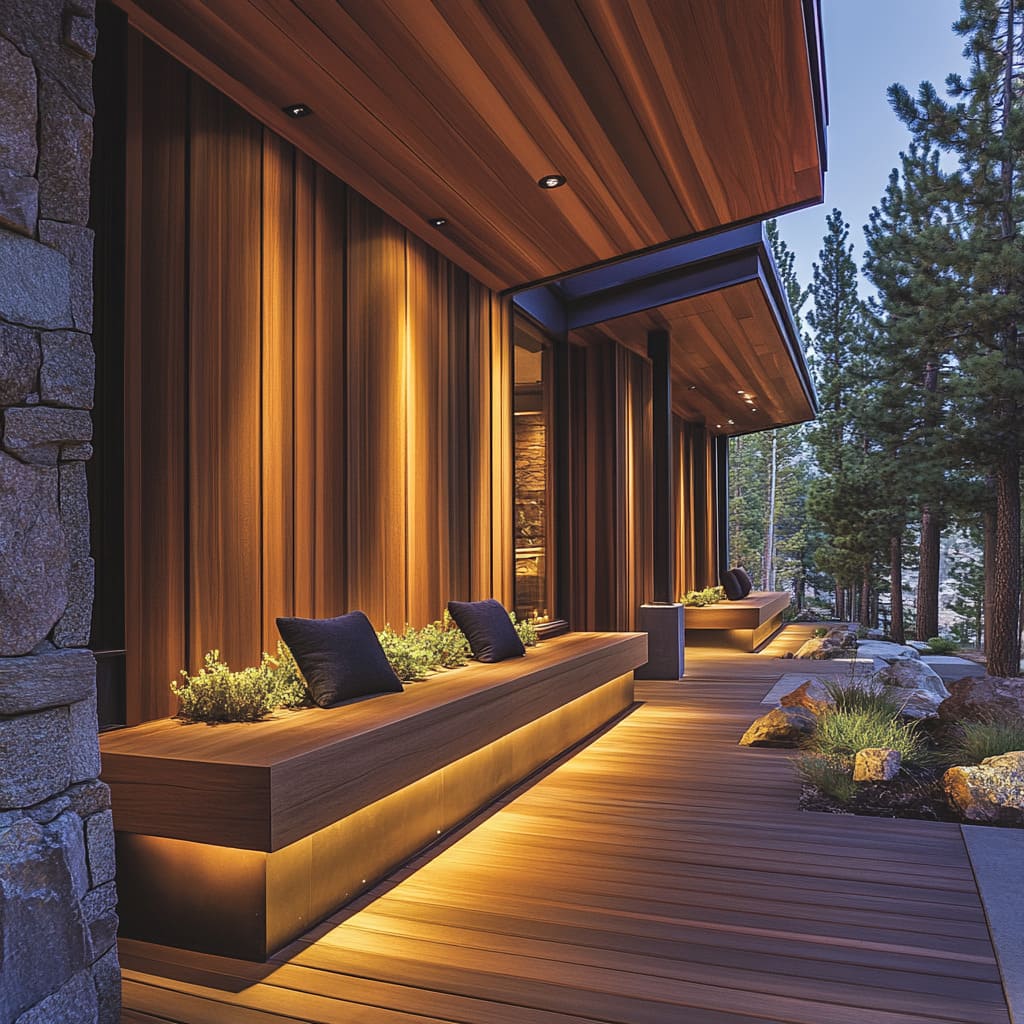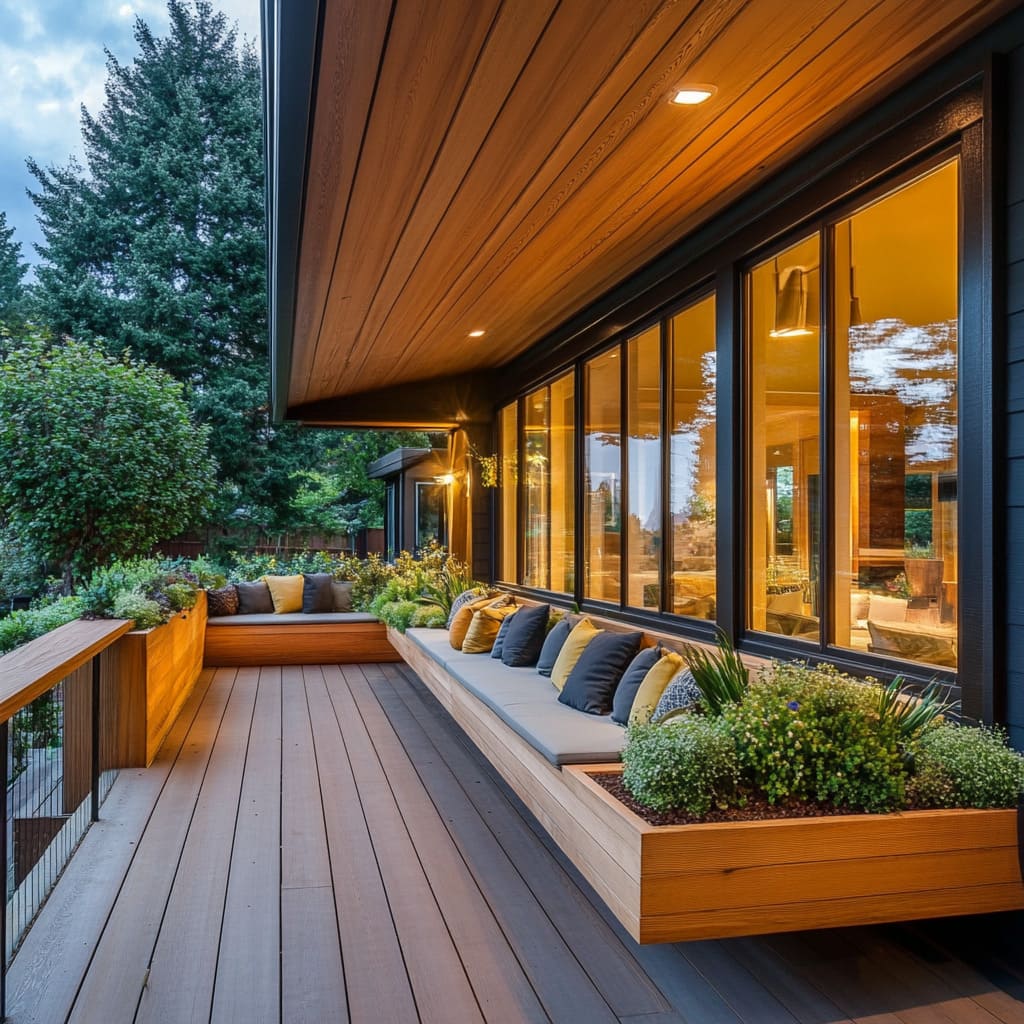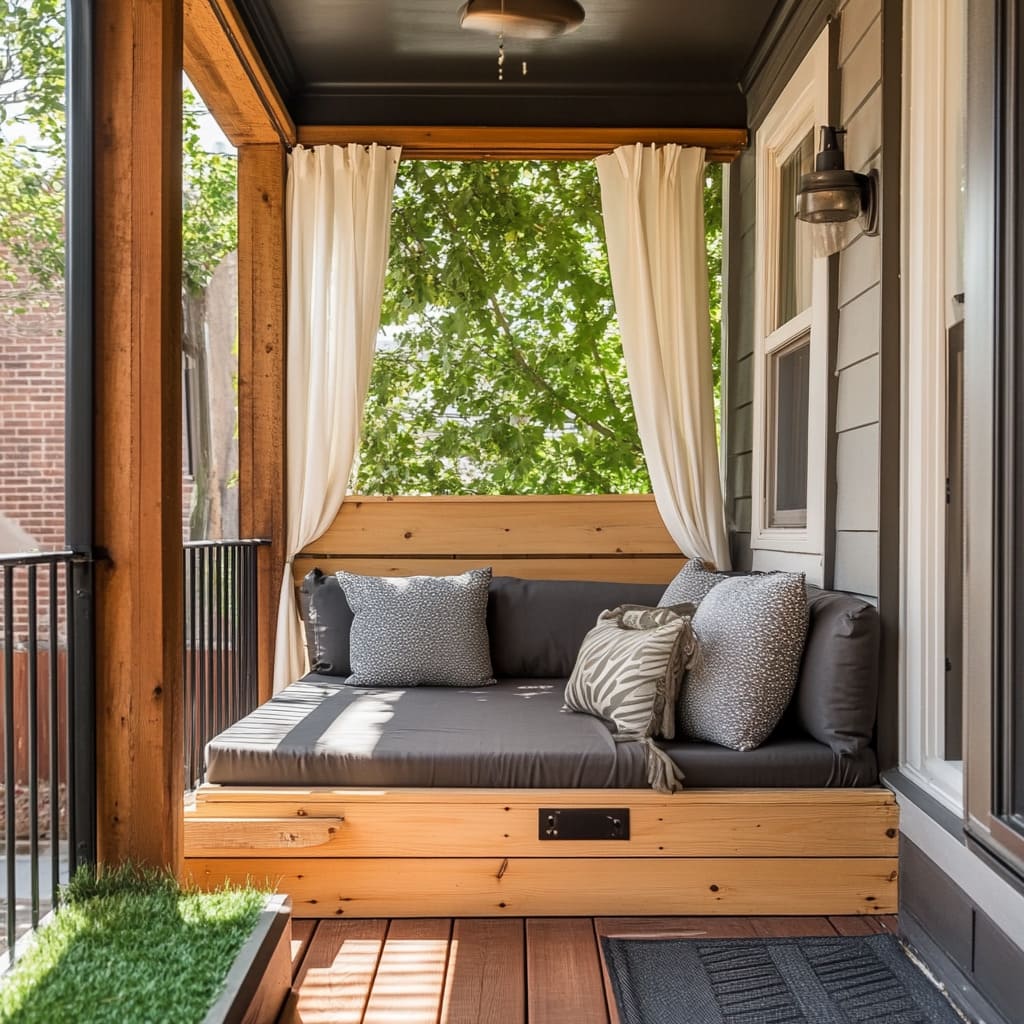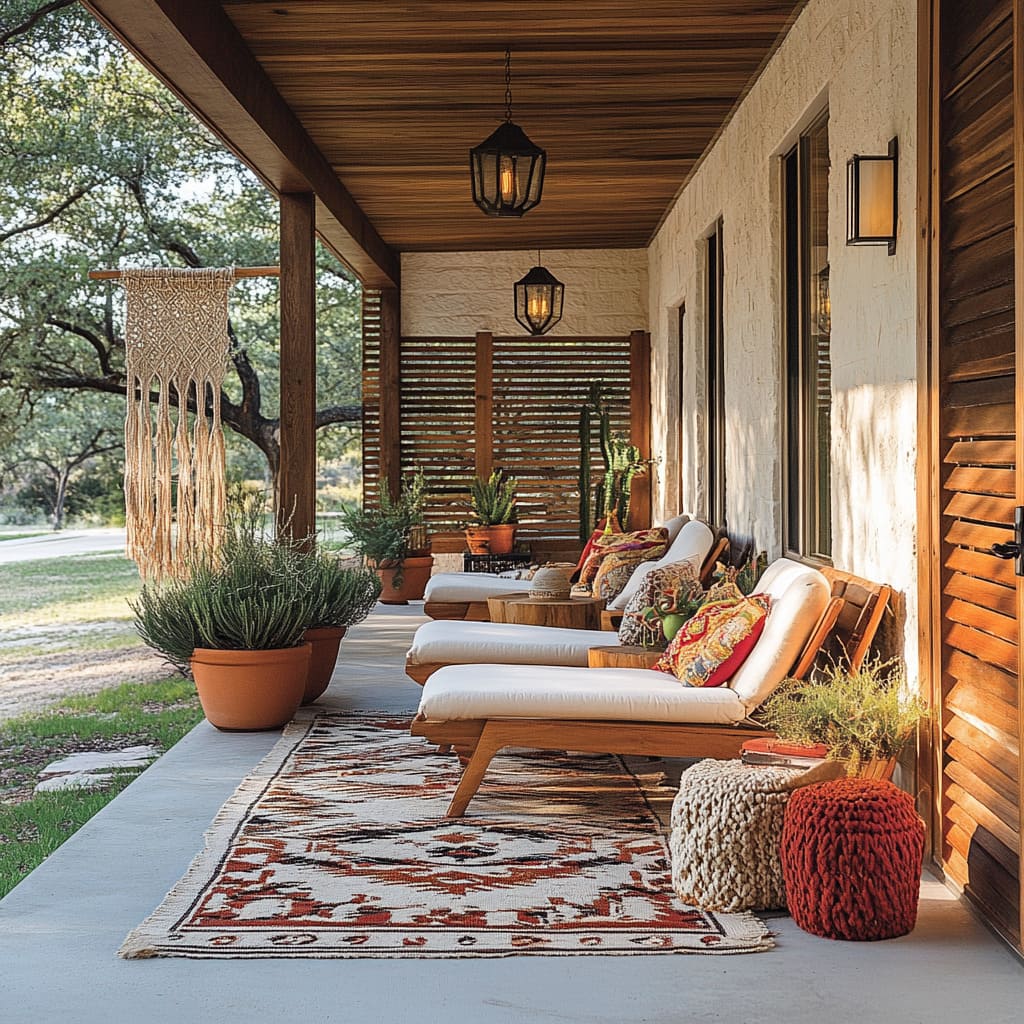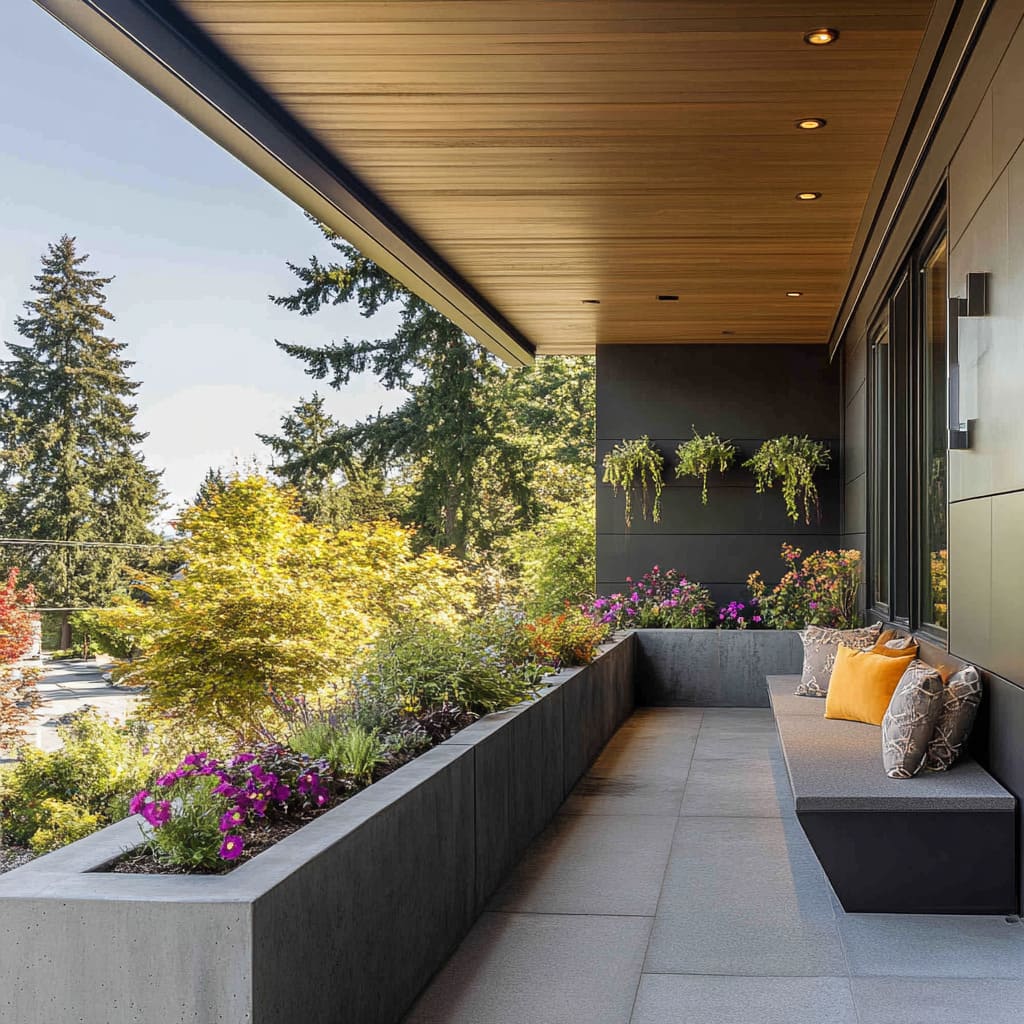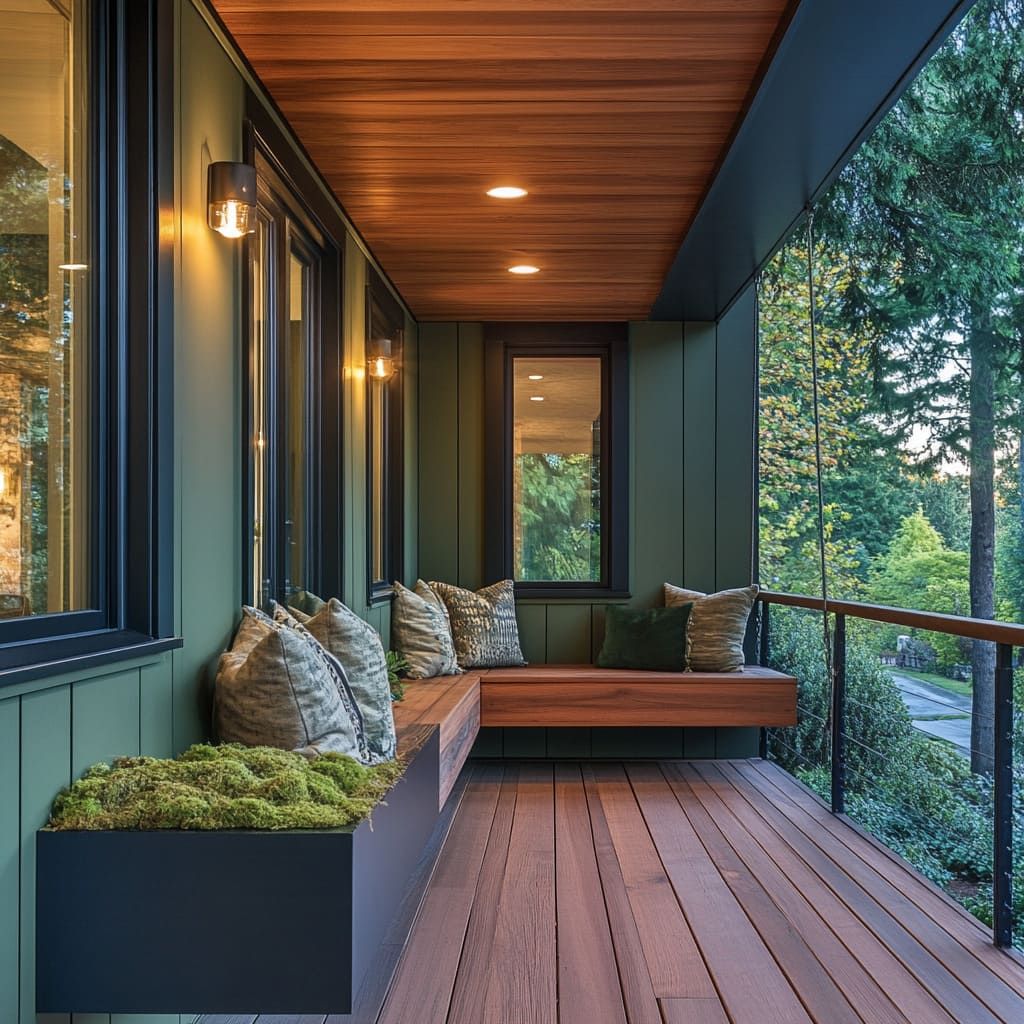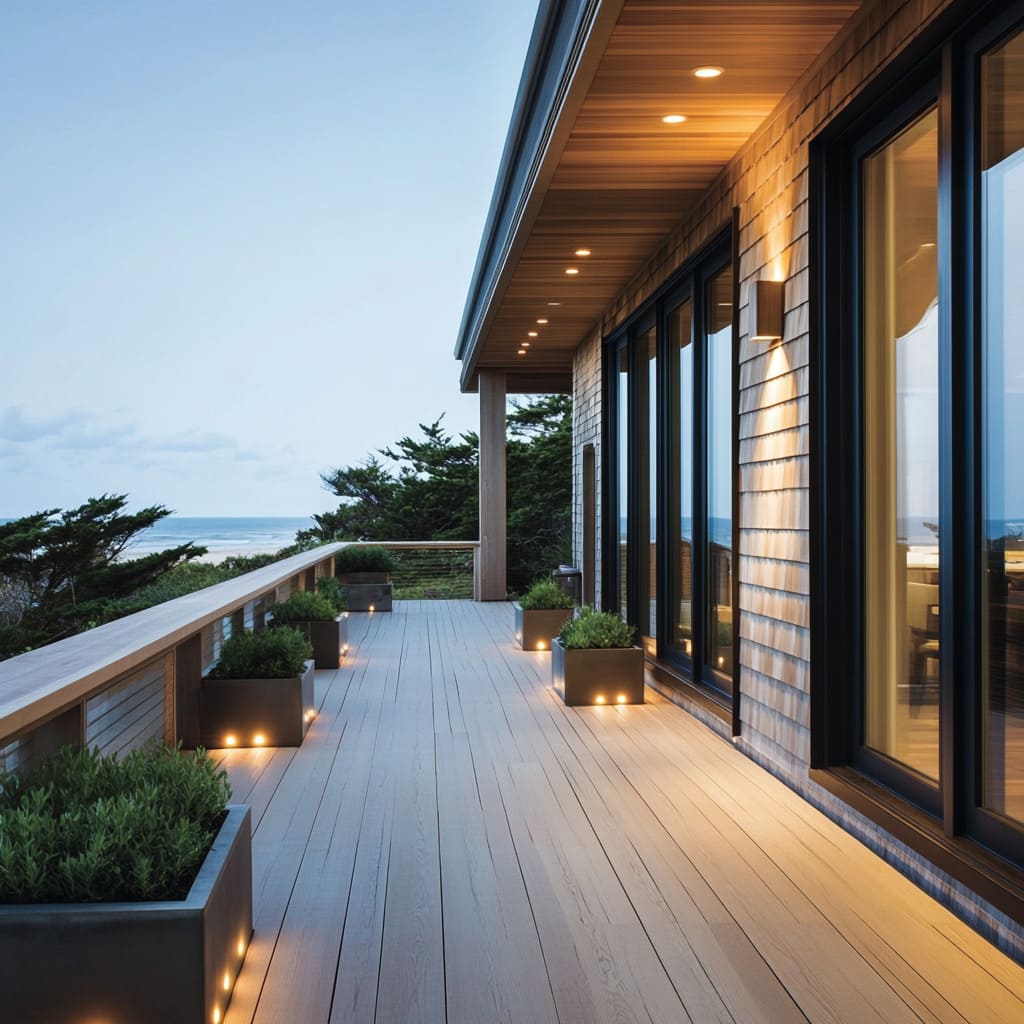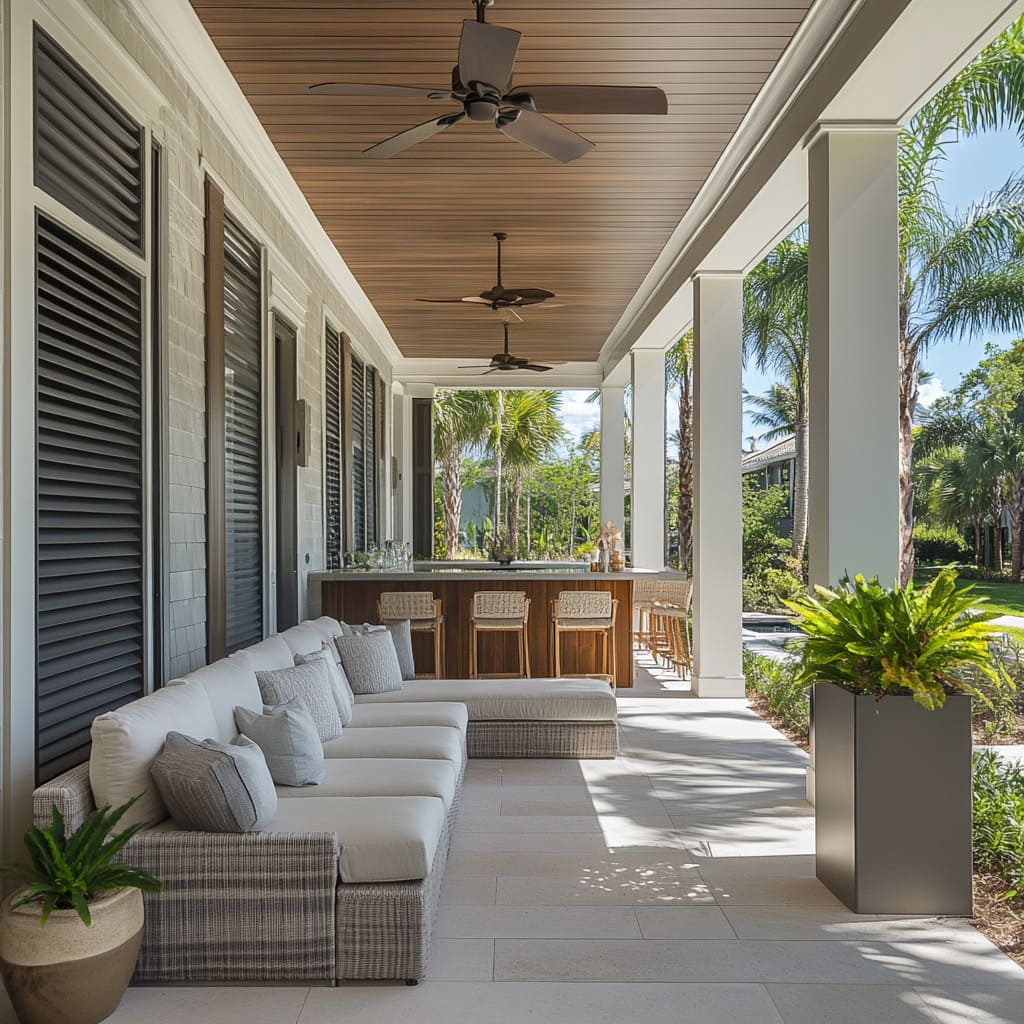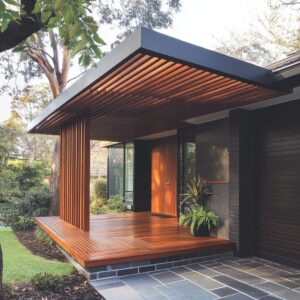A long porch offers more potential than many homeowners realize. Whether stretched along the front of a house or wrapping around a side yard, this extended space can serve as much more than a simple passageway.
Thoughtful design choices—some obvious, others more subtle—can shape a long porch into a comfortable, functional, and visually balanced outdoor living area. In many homes, especially those influenced by modern or transitional styles, long porches have become key features.
They’re used not only for lounging but for dining, entertaining, and quiet retreats. And while wide-open layouts may seem straightforward, the most successful long porches often rely on strategic planning.
Subtle alignment, material combinations, lighting, and privacy features all work together to create a space that feels intentional and connected to its surroundings.
This article explores the finer details that take a long porch from basic to exceptional. From floating benches and planter integrations to lighting tricks and climate considerations, each idea offers insight into building outdoor spaces that are both practical and stylish.
Whether you’re looking for ways to make a narrow porch feel wider or to create distinct zones for different activities, these concepts can help shape a porch that adds real value to any home.
Multifunctional Seating and Storage
Long porches often present a unique opportunity: they offer space, but they need thoughtful planning to keep them practical and welcoming. One of the most effective ways to achieve both is through seating that does more than offer a place to sit.
Built-in benches that stretch along a house façade or wrap around a corner are a common feature, but the smartest designs hide small details that make a big difference. At first glance, these benches might seem like simple additions.
But look closer, and you’ll notice they often serve double duty. Beneath a well-cushioned seat, you’ll find storage compartments tucked away.
Some have cubbies designed for shoes or baskets, turning part of the porch into a functional drop zone, especially useful for families who use the space as an entry point. Others include subtle heating panels hidden inside the bench structure, providing warmth in cooler months.
This mix of comfort and practicality makes a built-in bench an essential feature in many long porch designs.
Depth and Comfort
Not all porch benches are created equal. Some are built deeper, providing a place to stretch out for an afternoon nap or read a book, much like a daybed.
Others are kept shallower, offering a casual perch that works for quick chats or morning coffee. Getting the proportions right is key.
A deeper seat encourages people to relax and stay awhile, while a narrower one keeps things upright and conversational.
Material Coordination
Another detail that often goes unnoticed at first is how the bench ties in with the surrounding structure. Designers will often line up the slats of the bench with those of privacy screens or exterior cladding.
Trim details are mirrored from walls to seating, creating a sense of rhythm and consistency. This approach is especially effective on long porches, where visual repetition helps lead the eye through the space, making it feel cohesive and intentional.
Floating and Cantilevered Designs
One standout idea seen in modern porches is the floating bench. These designs are mounted to the wall with hidden supports, giving the impression they’re hovering just above the ground.
Aside from the clean aesthetic, there’s a practical reason for this choice—keeping the space underneath clear makes sweeping away leaves or dirt much easier. And when paired with low-profile LED lighting installed under the bench, the entire structure seems to glow at night, adding subtle ambiance without cluttering the space.
For homeowners searching for long narrow porch ideas, these types of multifunctional seating solutions can be a game-changer. Not only do they maximize limited space, but they also create opportunities for storage, relaxation, and even climate comfort without overwhelming the design.
Whether it’s a farmhouse porch in the Midwest or a sleek modern home along the coast, benches that blend form and function are a smart move.
Strategic Planting and Planter Innovations
Adding plants to a long porch is one of the easiest ways to soften hard edges and introduce life, but smart planting goes beyond filling a few pots with greenery. The best designs treat planters as tools for shaping space, guiding movement, and balancing privacy with openness.
Whether you’re styling a sleek modern home or something more rustic, plants and their containers play a bigger role than they get credit for.
Planter Integration That Defines Space
On long porches, planters often find their place at the ends of benches or along the outer edge of the deck. While this seems like a simple choice, it serves several quiet purposes.
Planters act as gentle dividers, breaking up an extended seating area into smaller, more comfortable sections. This is especially useful if the porch doubles as a dining space or a lounge—each planter helps signal where one “zone” ends and another begins.
They also guide how people move through the porch. A thoughtfully placed planter can steer foot traffic without the need for barriers.
For example, a tall, slender container next to a bench might subtly direct someone toward the steps, rather than across a private corner where someone’s reading or relaxing.
Keeping the View Clear
Many of the best long porches are built to capture a view—whether it’s the ocean, a mountain range, or just a well-kept backyard. That’s why planters tend to stay low in profile.
Tall shrubs or oversized pots are avoided, and the planting height is carefully controlled. When plantings stay below the height of the railing, the eye can travel easily to the landscape beyond, keeping the porch feeling open and connected to its surroundings.
Lighting That Adds Subtle Drama
One detail that takes planter design up a notch is the use of concealed lighting. Low-profile LED strips, tucked under the base of a planter or inside its edge, create a gentle glow that makes the planter seem like it’s floating after dark.
It’s a small addition with a big effect. This kind of lighting highlights the texture of trailing plants or grasses, while also helping guests find their way along the porch without harsh overhead lights.
It’s especially useful for long porches where nightfall can make the edges disappear into shadow.
Mixing Hard and Soft Textures for Balance
The containers themselves often bring structure to the porch design. Concrete, powder-coated steel, and smooth hardwoods are popular choices.
But pairing these sturdy materials with delicate, soft plantings is where the real magic happens. Think wispy ornamental grasses catching the breeze, trailing vines that spill over sharp metal edges, or a cluster of lavender offering both texture and fragrance.
It’s this push and pull—between the firm lines of the container and the softness of the plants—that gives the space its depth. This mix also works to soften the rigid geometry that’s common in many contemporary porches.
Long stretches of decking, cable railings, and clean architectural lines can feel a little stark on their own. Plantings break up that discipline and bring in a relaxed, approachable vibe without clutter.
For those looking for long narrow porch decorating ideas, these planter strategies are worth serious consideration. They make a porch feel layered and thoughtful, all while keeping the focus on function and flow.
Whether you prefer low-maintenance greenery or something more ornamental, the right planter arrangement can completely shift how the space feels—without taking up too much room.
Lighting as a Defining Feature
Lighting is one of the most underestimated tools for shaping how a long porch feels, both in daylight and after sunset. Done thoughtfully, it can frame views, guide movement, and bring subtle warmth to even the most minimal designs.
In fact, on long porches where lines tend to dominate, the way light plays along edges and surfaces can be what makes the space feel truly finished.
Layered Illumination That Builds Atmosphere
The most effective lighting schemes rely on layers rather than a single source. It’s less about overhead fixtures blasting light and more about creating soft washes and highlights that underline the architecture.
One of the most popular techniques is installing perimeter strip lights. These run along the outer edges of the decking, under railings, or tucked beneath benches.
The effect is subtle, but it draws the eye along the length of the porch, making it feel longer and more expansive. On narrow porches, this can be an easy trick to help visually widen the space.
The soft glow under a floating bench, for instance, gives the impression the seat is hovering slightly above the deck—clean, modern, and functional all at once.
Another approach that’s gaining ground is concealed wash lighting. This involves hiding LED strips behind planter boxes or slatted wood walls.
The light isn’t the star of the show here—it’s the way it highlights texture. At night, shadows from trailing plants or the grain of timber boards become more pronounced, adding depth and interest without overwhelming the eye.
One clever move is to give benches or planters a dual role. By adding lighting underneath these built-in features, they double as sculpture once the sun goes down.
The light creates silhouettes and contrasts, letting simple forms stand out even more. This is particularly effective on porches with streamlined architecture or strong geometric shapes.
Managing Reflections for Comfort and Impact
On porches that sit beside large windows, lighting requires a little extra thought. Glass reflects light, and without careful planning, this can lead to glare or awkward hotspots.
Many homes in coastal areas or open countryside now use tinted or low-reflectivity glass, which helps control the way porch lighting interacts with windows. The benefit isn’t just reduced glare inside the house—it’s also about amplifying the light’s impact on the porch itself.
Reflections can double the effect of ambient lighting, giving a sense of greater space and depth. For those thinking about decorating a long narrow porch, lighting can be an easy starting point.
It doesn’t require major construction or large furniture changes, and it can completely shift how a space is experienced. Whether the goal is to create a cozy corner for evening drinks or a seamless transition from indoors to out, good lighting ties everything together.
Material Coordination and Subtle Contrast
The most inviting long porches rely on materials that work quietly together, without shouting for attention. There’s an art to mixing wood, metal, and concrete in a way that feels balanced.
Each material plays its role—wood brings warmth, metal adds precision, and concrete delivers weight and durability. When these elements are combined thoughtfully, they create a space that feels grounded yet refined.
Wood, Metal, and Concrete Pairings
You’ll often find wood in the form of tongue-and-groove ceilings, benches, or slatted privacy screens. Its natural grain and soft color make it a perfect backdrop, especially in areas that get a lot of sunlight.
It softens hard surfaces and brings a sense of comfort to what might otherwise feel too stark. Cedar and teak are common choices because they hold up well outdoors and age beautifully, developing a silvery tone over time.
Concrete, on the other hand, brings a sense of stability.
Whether it’s poured-in-place planter walls, honed concrete flooring, or a floating bench slab, concrete is often used to anchor the space. Together, they create a balanced palette that feels clean without being cold.
Metal works as the detail piece in many long porch designs. Black powder-coated steel railings, slim bench frames, or simple hardware often provide a sharp contrast to wood and stone.
It’s the element that brings clarity to the design, drawing clean lines around softer materials.
Monochromatic Foundations with Small Pops of Color
A lot of long porches take advantage of neutral color schemes. Starting with a base of charcoal, taupe, or soft white helps avoid visual clutter.
This makes the space feel calm and orderly, which is especially important when dealing with a long stretch of outdoor living area. Once the foundation is in place, smaller accents add personality—think throw pillows in muted greens, rust-colored planters, or deep blue outdoor rugs.
These touches add interest without overwhelming the overall look.
Repeating Motifs Create Flow
One of the smartest tricks for tying different parts of a porch together is using repeating details. You’ll often see the same slat spacing on a privacy screen reflected in a bench design.
Railings might pick up the same line weight as window frames. This repetition makes everything feel unified, even across large areas.
On a long porch, where it’s easy for things to feel disconnected, these details help guide the eye and create a sense of flow.
Flooring Direction and Board Placement Matter
Deck boards aren’t just chosen for their material—they’re also laid with intention. Boards placed parallel to the length of the porch help emphasize its stretch, making it feel expansive.
On narrower porches, laying boards diagonally can trick the eye into seeing more width. The choice of board width makes a difference too.
Wider boards feel modern and clean, while narrower ones give a more traditional porch look. And tight seams with minimal gaps signal a high level of craft, showing that every piece was chosen and placed with care.
For anyone searching for long porch decorating ideas, paying attention to these material pairings and subtle contrasts can completely shift how a space comes together. It’s not about piling on details but about choosing the right ones, then repeating them with purpose.
Enclosure and Privacy: Screens, Slats, and Curtains
Creating a sense of privacy on a long porch doesn’t mean cutting it off from fresh air and daylight. Instead, the most effective designs use partial enclosures to balance shelter with openness.
It’s this balance that makes a porch feel inviting—whether it’s being used as a casual sitting space, an outdoor dining area, or a quiet spot to relax with a book.
Filtering Light and Framing Views
One of the most common features on modern long porches is the use of slatted panels. Whether they run vertically or horizontally, these screens offer control over how much of the outside world is visible—and how much privacy the porch enjoys.
Wider gaps between slats allow in more sunlight and offer unobstructed glimpses of nearby trees or garden beds. Tighter spacing reduces visibility while still letting the breeze pass through.
Slatted screens are often made from cedar, teak, or other durable woods that age beautifully over time. In some cases, powder-coated metal is used instead for a sharper, more streamlined look.
The decision usually depends on the style of the home, but both options give the porch structure without feeling heavy.
Curtains Add Flexibility
Fabric curtains are another simple way to give a porch privacy when it’s needed—and openness when it’s not. Light linen panels, for example, can be drawn to one side during cooler mornings, letting the space feel open to the yard.
As the day heats up, they can be pulled across for shade. In coastal or breezy areas, curtains add a sense of movement, catching the wind and softening the porch’s lines.
They also help filter direct sun, cutting glare while maintaining an airy atmosphere. And because they’re easy to tie back or let down, curtains are a flexible choice for porches that get used in different ways at different times of day.
Defining Outdoor Rooms on a Long Porch
Long porches work best when they’re broken into smaller, purposeful spaces. Instead of one endless row of seating, good design finds ways to create separate zones.
A set of slatted panels might separate a quiet lounge area from a spot set up for outdoor dining. Ceiling changes can help here, too—switching from tongue-and-groove wood over the sitting area to an open pergola over the dining space, for instance, gives each area its own feel.
Planters can also define zones. Tall containers filled with grasses or shrubs act as informal partitions, offering privacy between seating groups without closing off the space completely.
On larger porches, even subtle changes in flooring direction can help set one zone apart from another. The key is to make sure each space has a clear purpose—whether that’s a spot for morning coffee, an area for dinners with friends, or a corner for reading in the afternoon light.
Dividing the porch like this ensures it never feels too open or unfinished, no matter its size.
Seasonal and Climate Considerations
A long porch can serve as a true extension of the home, but only if it’s designed with climate in mind. Thoughtful planning makes the space comfortable all year round, whether it faces snowy mountain views or sun-soaked coastal breezes.
Focusing on Warmth in Cold Regions
In colder areas—think mountain homes or higher elevations—porches need to offer more than shelter. They need to create a sense of warmth that draws people outside even when the temperature drops.
Heated benches are one feature that’s becoming increasingly common. These benches are often crafted from timber or concrete, with heating elements tucked inside or beneath the seat cushions.
The warmth is subtle and steady, keeping the seating area inviting without making it obvious where the heat source is coming from.
Linear fire features are another favorite in these settings. They often run along the length of the porch, either built into a raised bench or recessed into a concrete wall.
They don’t overpower the space—they provide a steady line of heat that makes gathering outdoors possible even on cooler nights. Many are designed with sleek, minimal finishes that blend into the overall porch layout, whether it’s rustic or modern.
Porches in cold regions also tend to use heavier materials. Thicker wood beams, stone walls, and wide decking boards all add a sense of permanence and help the space feel grounded.
These choices not only hold up well in harsher climates but also offer insulation against wind and cold.
Breathable Layouts for Humid and Hot Areas
In coastal towns and humid regions, the priorities shift. Staying cool becomes the focus.
Long porches in these climates usually incorporate wide overhead fans, often with simple black or matte metal finishes. These fans help circulate air, making the space feel cooler without relying on heavy shade structures alone.
Cross-ventilation is also key. Railings made of thin cable lines or slatted wood panels allow breezes to pass through freely, preventing the porch from becoming stuffy.
In homes near the water, where air movement is constant, this makes a huge difference in day-to-day comfort.
Materials are chosen carefully in these climates too. Composite decking is popular because it resists moisture, doesn’t warp, and requires little maintenance.
Powder-coated metals are used for railings and furniture frames, offering durability without sacrificing style. Lighter color palettes—think sandy beige, pale gray, and soft white—reflect the sun’s rays, keeping surfaces cooler underfoot.
Even cushions and fabrics are chosen for their UV resistance and breathable textures. For areas that get heavy rain, slightly pitched floors and discreet drainage systems are often worked into the design.
This helps prevent pooling water, which can lead to slippery surfaces or mildew. Whether designing for cold winters or hot, humid summers, the goal is always the same: to create a porch that invites people to stay.
A space that responds to its climate, making it useful throughout the year, is one that adds real value to any home.
Noteworthy Subtleties and Illusions
Some of the most impressive porches don’t rely on dramatic features. Instead, they use subtle design choices that quietly shape how the space feels.
These small moves might go unnoticed at first, but they make all the difference in creating a porch that feels thoughtfully finished rather than simply put together.
Architectural Alignment That Feels Effortless
One of the easiest ways to create a sense of calm and order on a long porch is through careful alignment. Designers often position built-in benches, planter boxes, and even narrow fire features so that they line up perfectly with siding seams or window mullions.
It sounds like a small thing—and it is—but this kind of precision helps bring harmony to the entire façade. The result is a space that feels balanced, even if most visitors can’t immediately put their finger on why.
This technique is especially common in homes where clean lines are part of the overall style—whether it’s a modern farmhouse or a coastal retreat. Aligning elements from top to bottom gives the porch a rhythm that feels consistent and intentional.
The Lightness of Floating Effects
There’s something striking about heavy materials like concrete or timber appearing to hover above the ground. Achieving this effect usually involves hidden brackets or steel supports that are built into the structure, keeping everything stable but out of sight.
The end result is a bench or planter box that seems to float. It reduces the visual weight of the materials and makes the space feel more open.
Lighting can take this effect even further. A slim strip of LED light tucked beneath a floating bench adds a gentle glow after dark, enhancing the sense that the structure is suspended in midair.
It’s a simple trick that brings a lot of visual interest without adding clutter.
Stretching or Compressing the Perception of Space
Long porches come with a challenge: how to make them feel neither too narrow nor too stretched out. One clever solution is to play with lighting and repetition.
Running a continuous strip light along the perimeter of the deck, for instance, can draw the eye from one end to the other, emphasizing the length and making the space feel larger. Alternatively, repeating vertical or horizontal lines through slats, beams, or railing designs can add structure and rhythm.
These lines guide the eye and help break up the expanse of the porch without adding bulky furniture or barriers.
Subtle Color Accents That Add Life Without Overwhelming the Space
Instead of relying on large areas of bold color, many long porches use small, purposeful accents to add personality. This might mean a pair of rust-colored pillows on a bench, a planter filled with deep green grasses, or a cluster of pots in soft earth tones.
The goal is to keep the base palette consistent—usually a mix of natural woods, stone, and black or gray metals—while adding just enough contrast to bring life to the space. In general, these accents work best when they tie back to the environment.
A porch overlooking the woods might include cushions in shades of moss and bark, while a porch in a coastal area could pick up the soft blues and sandy beiges of the nearby shore. Incorporating these subtle choices is a key part of successful long porch design.
Whether you’re fine-tuning the alignment of built-in features or choosing just the right shade for a planter, these details work together to create a space that feels complete. And for homeowners searching for ways to bring polish and style to their outdoor areas, paying attention to these subtleties is often the difference between a porch that’s ordinary and one that stands out.
Conclusion
Long porch design is often underestimated at first glance. What might seem like a simple layout of benches, planters, or lights is usually the result of carefully considered choices.
Beneath each element—whether it’s a floating timber bench, a row of low-profile planters, or a subtle line of LED lighting—there’s a strategy that shapes how the space feels and functions. The best long porches are thoughtfully balanced.
Floating seating with hidden supports creates a sense of lightness, while heavy planters and stone walls bring grounding weight. Repeating slats, matched alignments, and clean lines tie everything together, even across large spans.
Layered lighting works quietly to define zones and extend the use of the space after dark, whether for relaxed evenings or casual gatherings.
At their best, these porches aren’t simply outdoor corridors. They’re adaptable outdoor rooms that merge structure and comfort.
Privacy screens, ceiling treatments, and even the direction of deck boards play a role in how welcoming and useful the porch becomes. For anyone looking to create a space that feels effortless, these are the ideas worth focusing on.
Paying attention to the small details—material transitions, alignment with windows or siding, and subtle color accents—can turn an ordinary porch into a standout feature of the home. Whether drawing inspiration from modern coastal homes or mountain retreats, the goal stays the same: to make a long porch feel inviting, balanced, and connected to the surrounding environment.
